
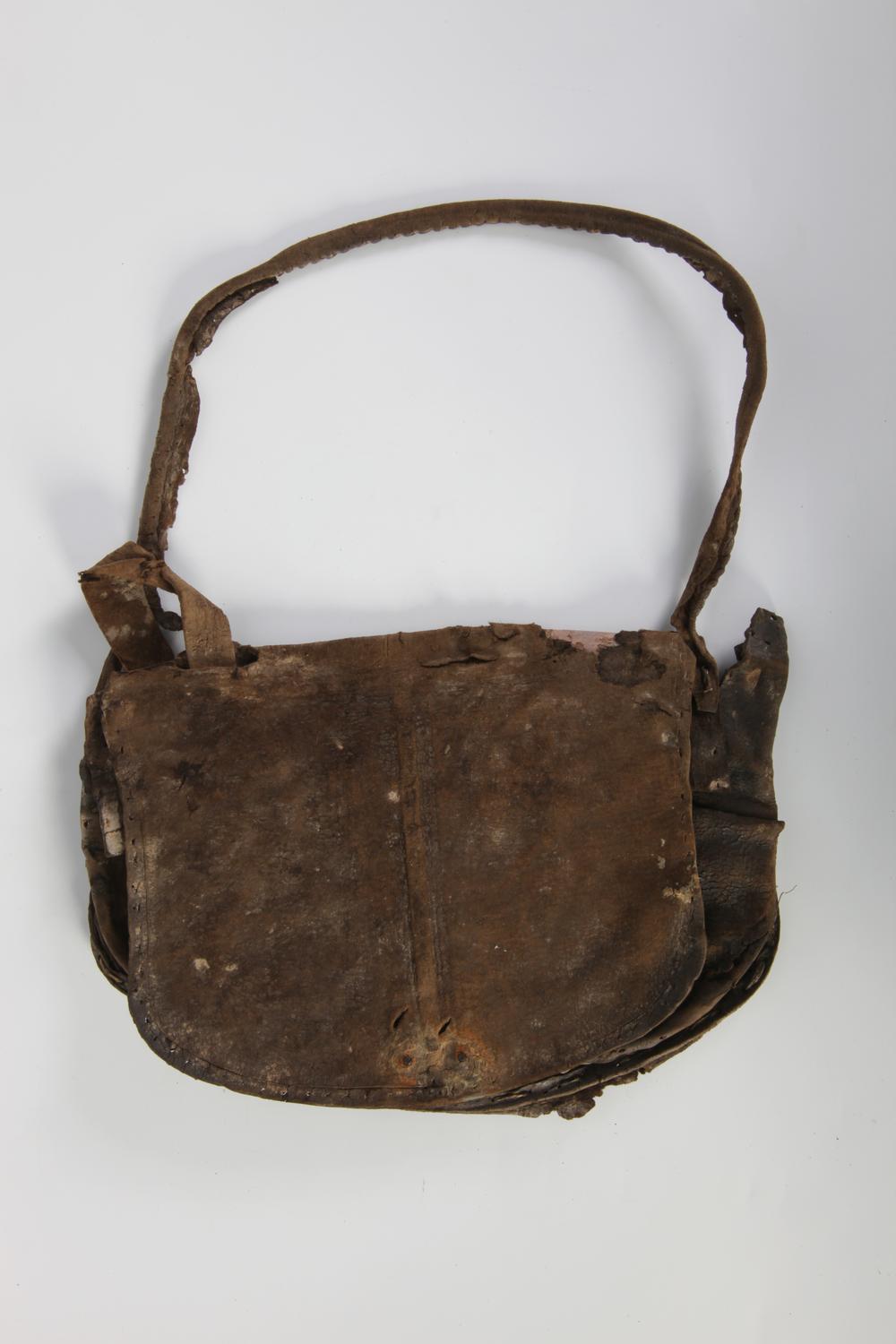
(1/ )
Modern period [1492 / 1789]
Aumonière composed of nine leather elements: the back and its lining, a flap,
a front plate in the shape of a crescent with truncated points, two small triangles with truncated points mounted on the front plate, an insert between these two pieces, a saddle edge and a piping. The decoration consists of four parallel lines delimiting a central rib on the flap. A metal clip allowed the closure.
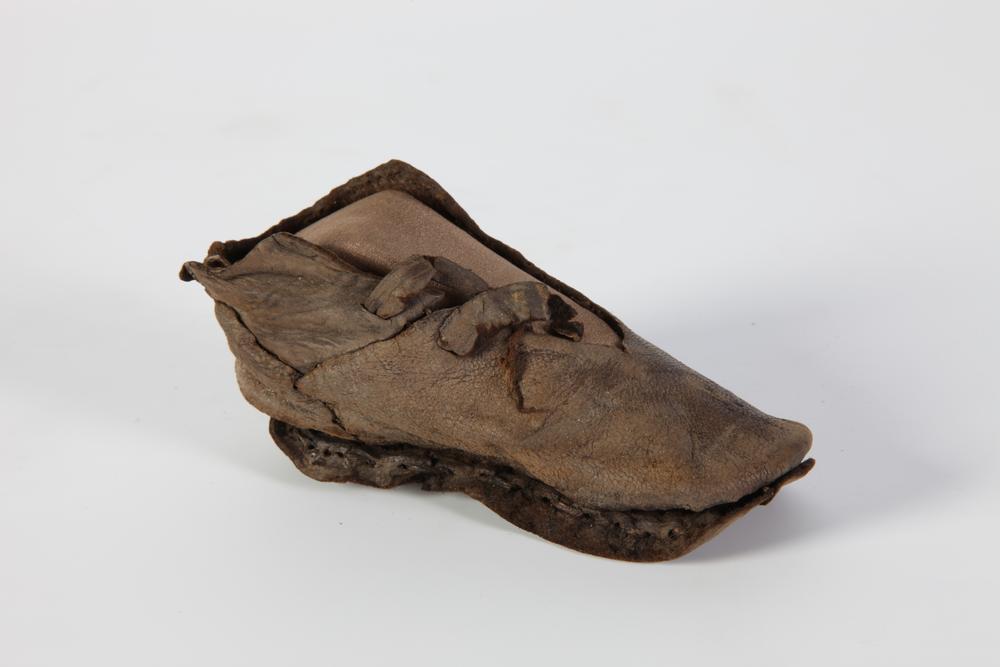
(2/ )
Modern period [1492 / 1789]
High shoe of child, left foot, closed by two laces. The upper is made of six elements: a stem wrapping the foot, a quadrangular element, a tongue and a strap (disappeared), a counter and a bifid lace. The sole is not worn.

(3/ )
Modern period [1492 / 1789]
Low shoe, perhaps left foot, consisting of eight elements: open vamp following the front axis of the foot, two half quarters, a tongue, a counter, a strap and two legs. The closing system and the sole have not been preserved.
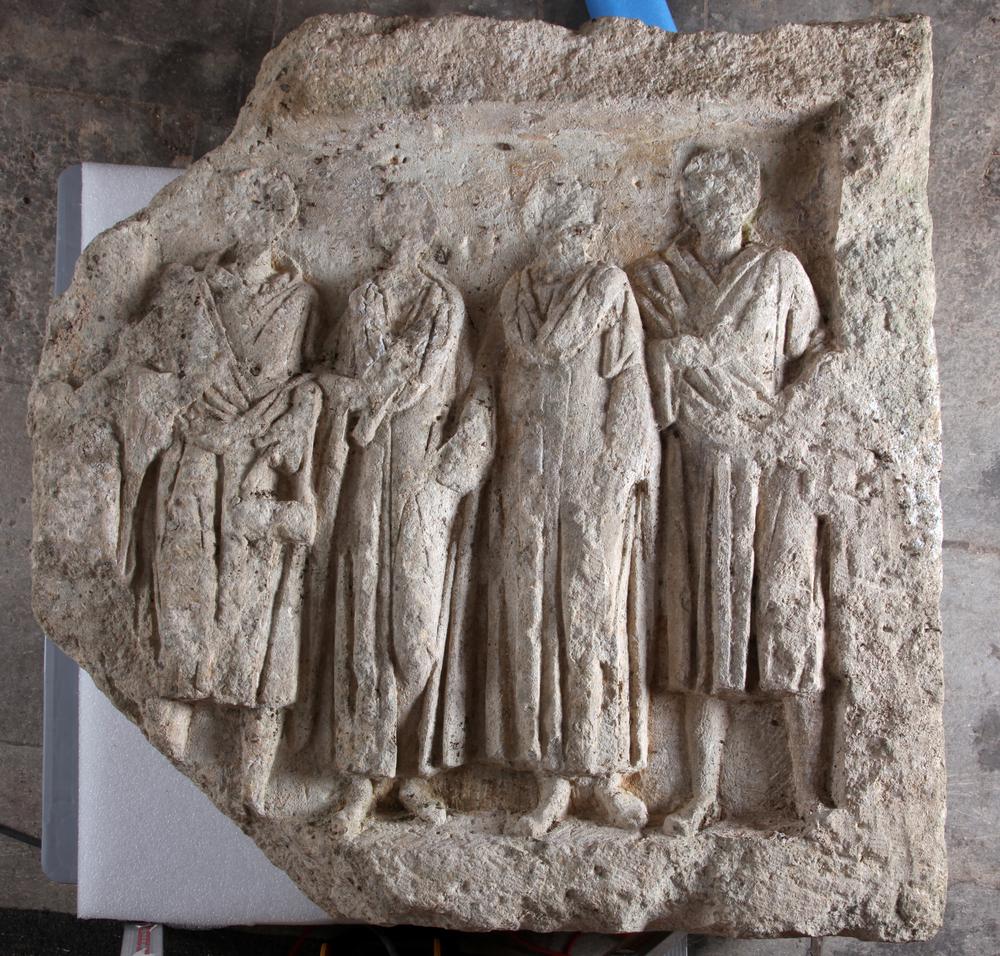
(4/ )
Gallo-Roman [- 50 / 476]
Stele in an elongated rectangle. The top, the right side and the bottom of the legs of the figure on the extreme left are missing. The lintel of the stele, still in place in 1995, has since disappeared, as well as the head of the figure on the far right. The whole is worn, especially the faces. Traces of point and gradine.
Niche with straight lintel and flat bottom. The jamb has no decoration. Four figures, in low relief, are standing and more or less facing. On the far left a man is slightly turned to the right and hinged to the left with his right leg bent. He wears a tunic, with a collar at the neck, which covers him up to the middle of his calves, with large vertical folds. Over it is a long hooded cloak of the paenula type, with V-shaped folds on the chest and straight at the bottom. He is holding a cassette with shelves in his left hand and the right hand is holding one side of the cloak. Next to him is a woman, haunched on the right, with narrow shoulders wearing a long tunic that reaches to the top of the ankles. The collar is close to the neck and the sleeves are long. Her shoulders are covered with a wide drapery of the same length, with oblique folds. His right arm is folded up the side of this garment and the right hand holds a mappa. The left hand holds the right hand of her neighbor. The latter, haunted on the right, is dressed in the same way. On the far right is a man, hanged on the left, who looks to the left. His head is round and his headdress is short. His tunic goes down to the middle of his calves with straight folds. He is also wearing a paenula, with V-shaped folds, which forms a bulge across the abdomen. His right arm, folded against the chest, has the hand that holds a flap of the coat.
The funerary stele concerns two couples. The insufficient width of the monument forced the sculptor to reduce the width of the two women, especially the one on the left. The barrel of the man on the right is 6.5. M.-R. Ormasti dates the stele to the first half of the 2nd century, because of the elongation of the figures, but this particularity is rather used at the end of this century.
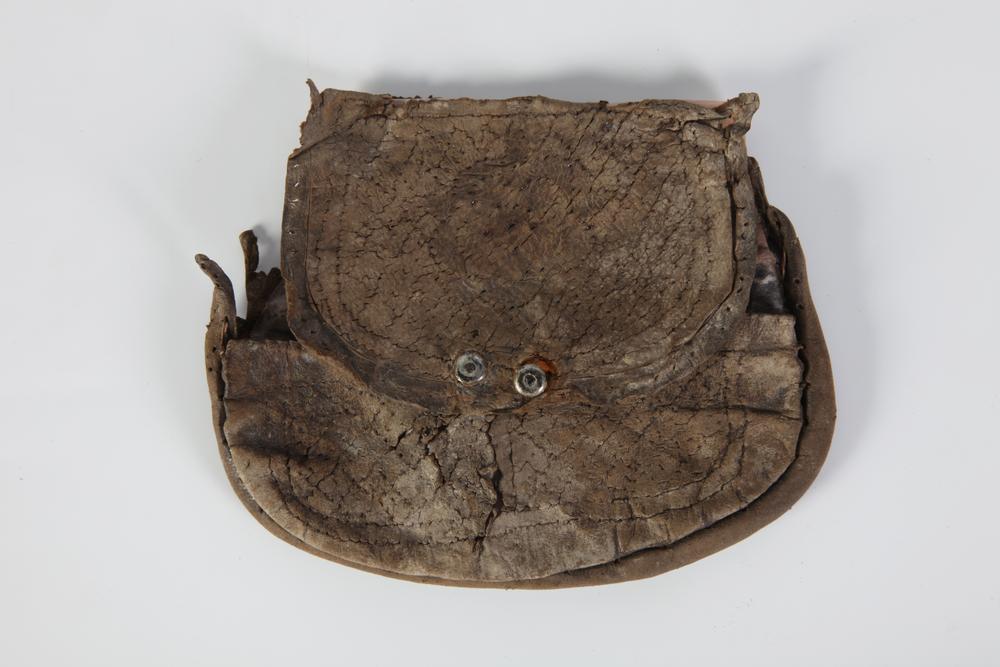
(5/ )
Modern period [1492 / 1789]
Aumonier composed of nine leather elements: the back and its lining, a flap, a front plate in the shape of a crescent with truncated points, two small triangles with truncated points mounted on the front plate, an insert between these two pieces, a saddle edge and a piping. Perforations seem to indicate the presence of an embroidered decoration disappeared. A metal clip allows the closure.
4th quarter of the 15th century - early 16th century.
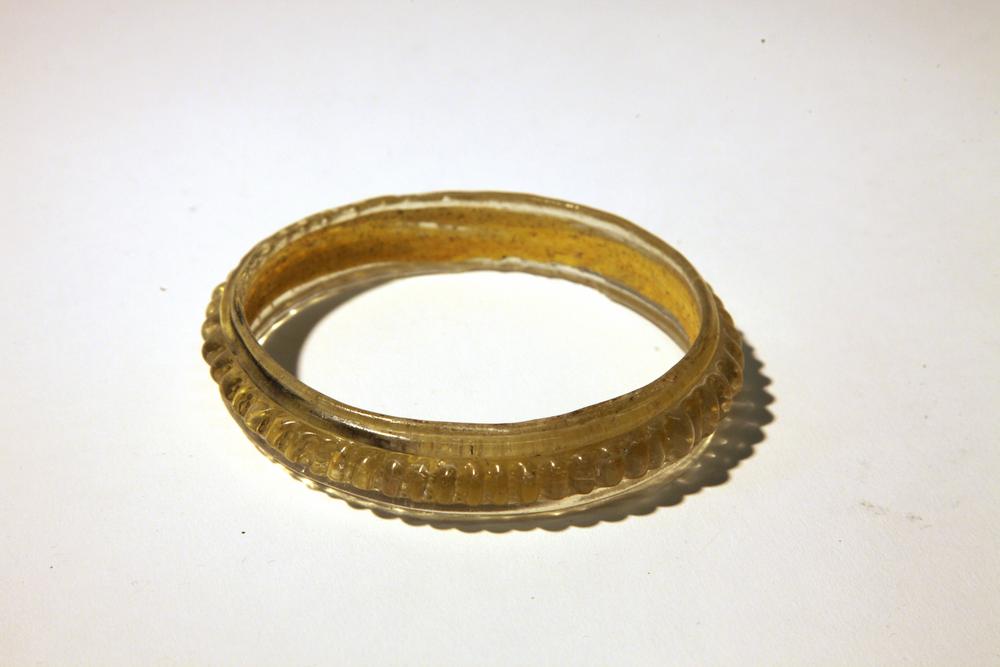
(6/ )
2nd Iron Age [- 480/ - 50]
Discovered in a burial tomb, it was generally the attribute of a woman. The deceased wore a glass bracelet on his left forearm that was found intact. The fragmentary nature of the skeleton made it impossible to distinguish the sex of the individual with any certainty. The bracelet was not soldered, as was always the case at that time, and was made by stretching a glassy mass. A decoration forming a notched relief develops on the external circumference. In Lorraine, bracelets belonging to the same family have been found in Liverdun, Villey-Saint-Etienne and Woippy.

(7/ )
2nd Iron Age [- 480/ - 50]
Discovered in a warrior's cremation tomb dated to the 2nd century BC, this iron spear was wedged between the urn and the wall of the excavation. Next to it were a shield umbo and fragments of iron plate from the scabbard of a sword. This spear, probably related to a heel found in the same context, has a foliated flame and a strong axial rib. It was fitted with a socket and rivets, the holes of which can still be seen on the mouthpiece. The length and width of the tip suggest that it is a spear, a stabbing weapon kept in hand during combat.
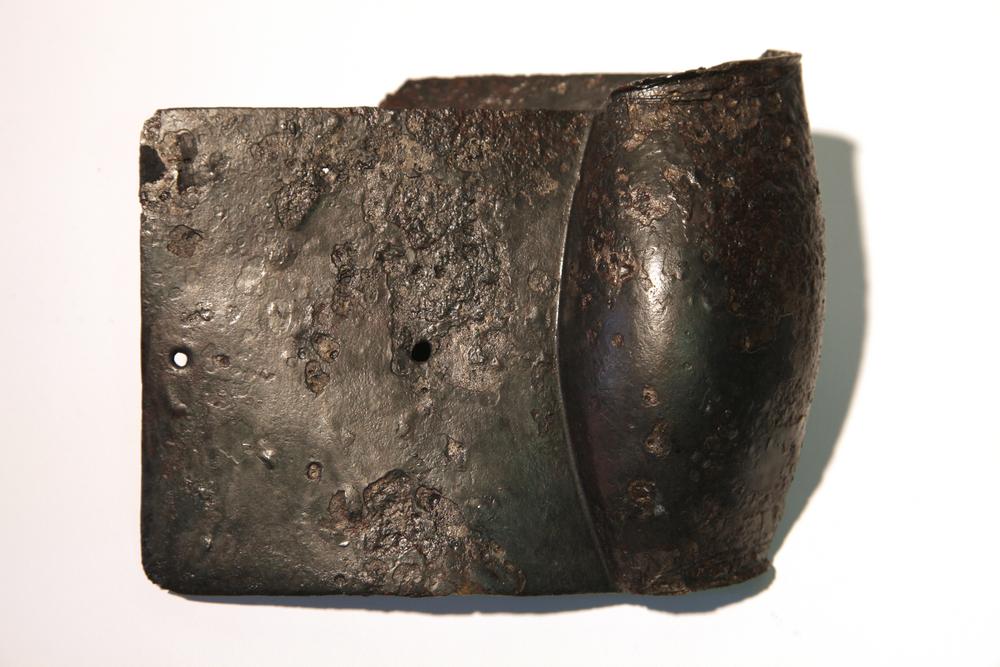
(8/ )
2nd Iron Age [- 480/ - 50]
Umbo discovered in the same context as the Mondelange spear. This object is made up of an ovoid shell, with rectangular fins pierced with holes. Small rivets were used to maintain the umbo on the surface of the shield. The shape of this piece is typical of the Tène C2 (180-130 BC). Deliberately folded, this umbo probably played a symbolic and ritual role in the burial of the deceased. This type of degradation is part of a context of sacrificial breaking of weapons observed, at this time, in sanctuaries and tombs.
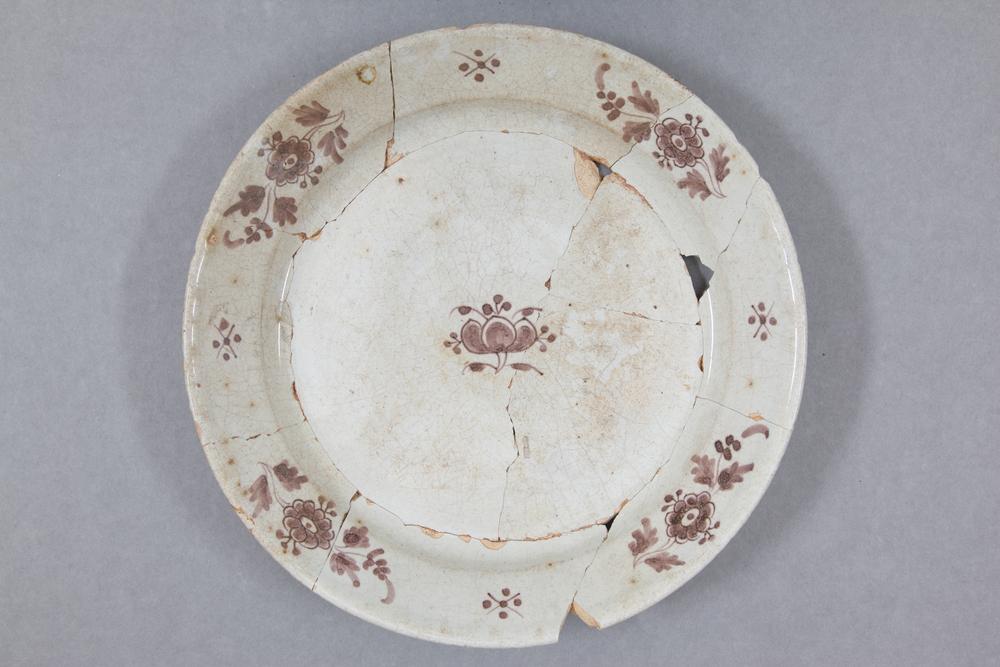
(9/ )
Contemporary period [1789 / nowadays]
Soup plate with plant decoration in brown camaieu. The bottom is decorated with a single flower. The wing is decorated with four flowers surrounded by a bouquet of leaves. A geometrical decoration made of five dots distributed on and around a cross separates each secondary floral decoration present on the wing.
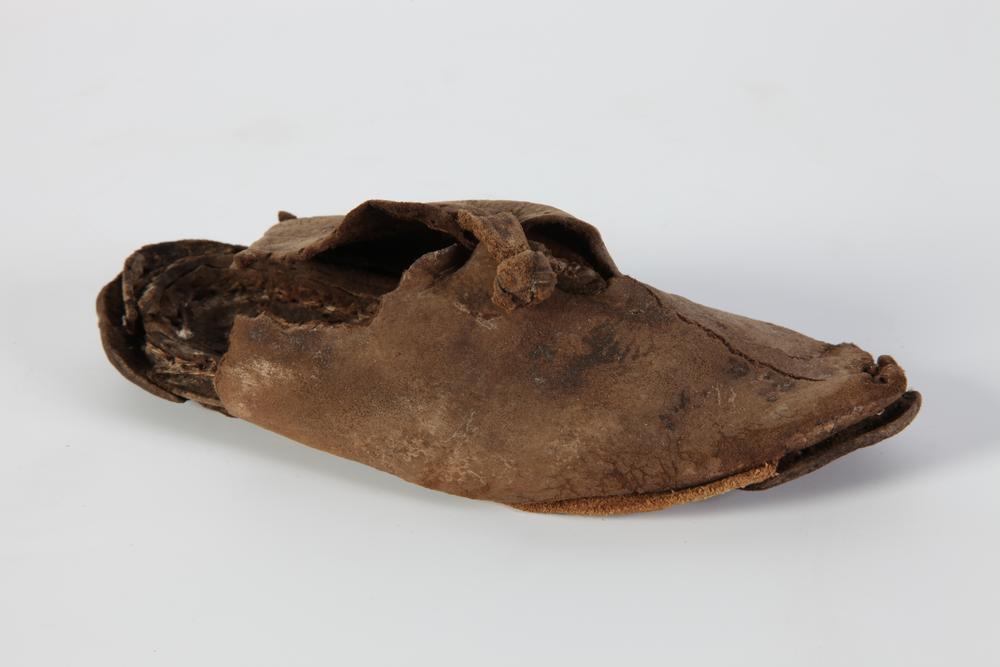
(10/ )
Modern period [1492 / 1789]
Child's left shoe closed with a knotted leather button. The quarter is missing.

(11/ )
Classical Middle Ages [1000/ 1300]
"Bottle with globular body and bottom in umbilical. It is decorated with a net of coarse nets on the body. Its neck is wide, with a very flared lip."
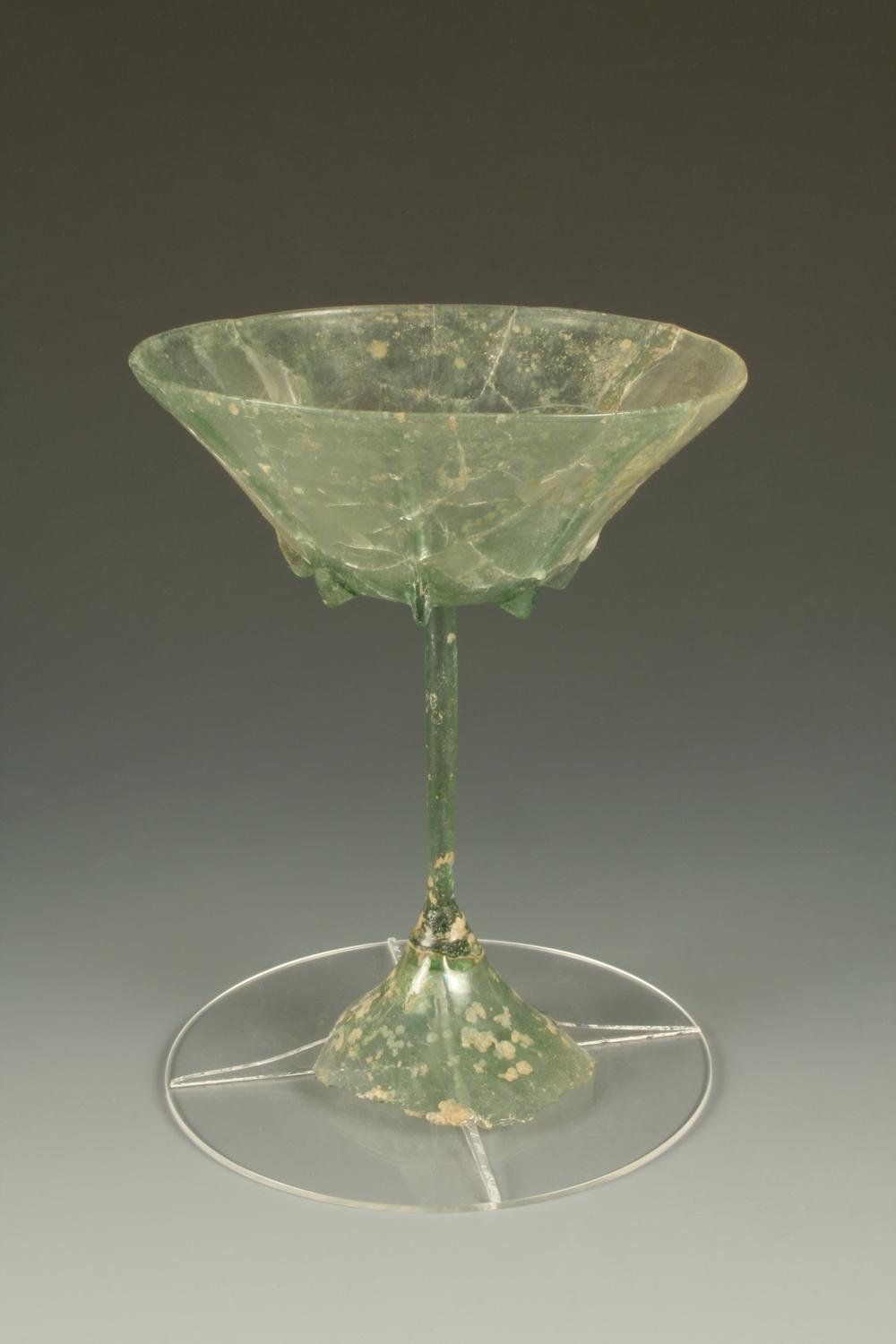
(12/ )
Late Middle Ages [1300 / 1492]
Blown molded cut with pinched protruding ribs. Full and thin stem. Fluted foot. "In the family of stemmed glasses, a group well attested in the North of the Loire takes up the ribbed decoration already met on the stocky goblets. Remarkably illustrated by this glass, this group places a flared cup decorated with protruding ribs taken up with tongs on a slender leg, formed by a thin solid glass stem, itself hot-bonded to a conical foot, here fluted."
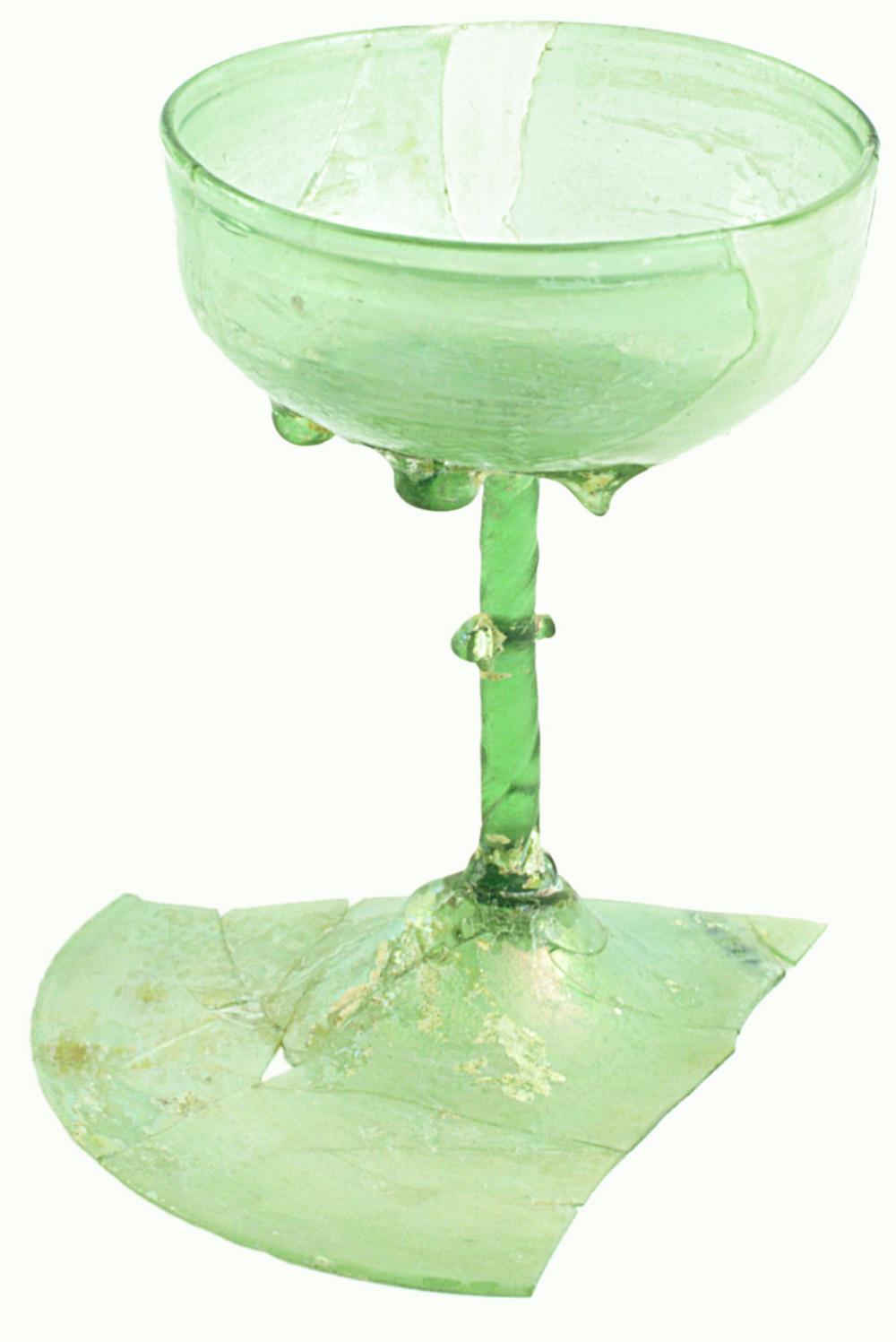
(13/ )
Late Middle Ages [1300 / 1492]
"Blown glass cup molded with decoration of small points and rosette of petals. The base is underlined by a cord of pinched glass. Twisted stem decorated with a trick of glass net. Discoid foot." Archaeology and Uses of Glass, Cat.114. "With its chalice-shaped bowl decorated by molding a network of small dots and petals, example #114 is related to a well-known series of glasses produced in the Argonian workshops of Pairupt (commune of Lachalade, 55) and Bercettes. The rather limited range of decorations is obtained by blowing the material in an open mold.
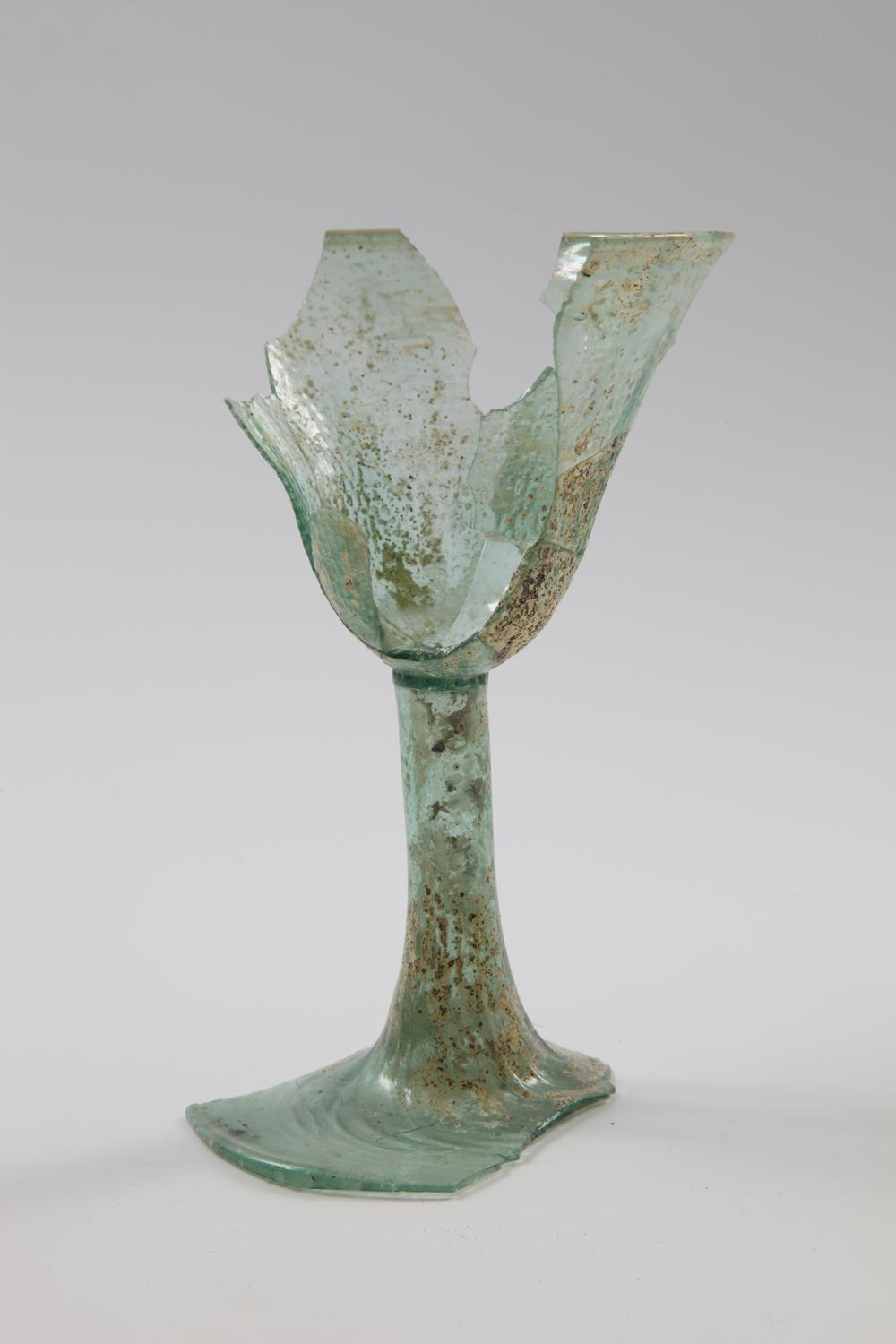
(14/ )
Classical Middle Ages [1000/ 1300]
"Moulded blown glass with alternating depressions and ribs (cup). Moulded blown glass with twisted ribs decoration (stem and foot)."

(15/ )
Modern period [1492 / 1789]
Bottle with a bubble-shaped body flattened laterally and with a long neck. The bottom is upside down.

(16/ )
Modern period [1492 / 1789]
Moulded blown glass with embossed decoration. Deeply moulded bottom. "Discovered in Metz, these glasses illustrate the coexistence on the Lorraine Renaissance market of glass productions of different traditions. The first three (cat.120 to122) attest to the diffusion in Lorraine of productions from the German forests. The embossed cups with upset bottoms (cat.120) are well known in the Rhine valley until the early 16th century, where they were sometimes used as reliquaries (maigelen)."
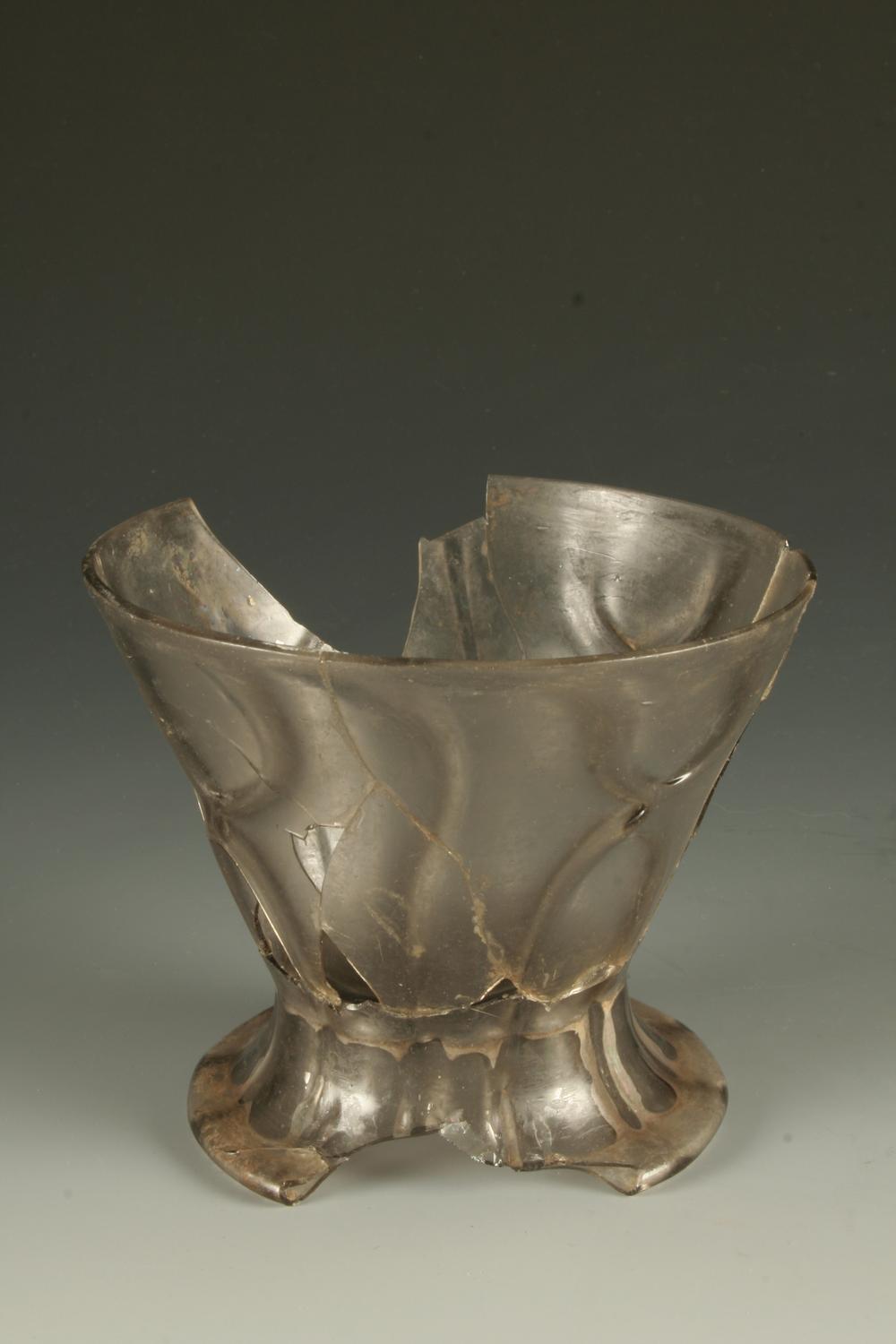
(17/ )
Modern period [1492 / 1789]
Moulded cup with ribbed decoration, eight of which are pinched and joined together. Low pedestal and upside down. "This greyish glass goblet, very slightly iridescent due to its burial, is one of the most beautiful representatives of these pedestal glasses very popular during the Renaissance. While this beautiful object offers an original variation of the ribbed decoration, the following examples illustrate the diversity of the ornamental palette of this group."
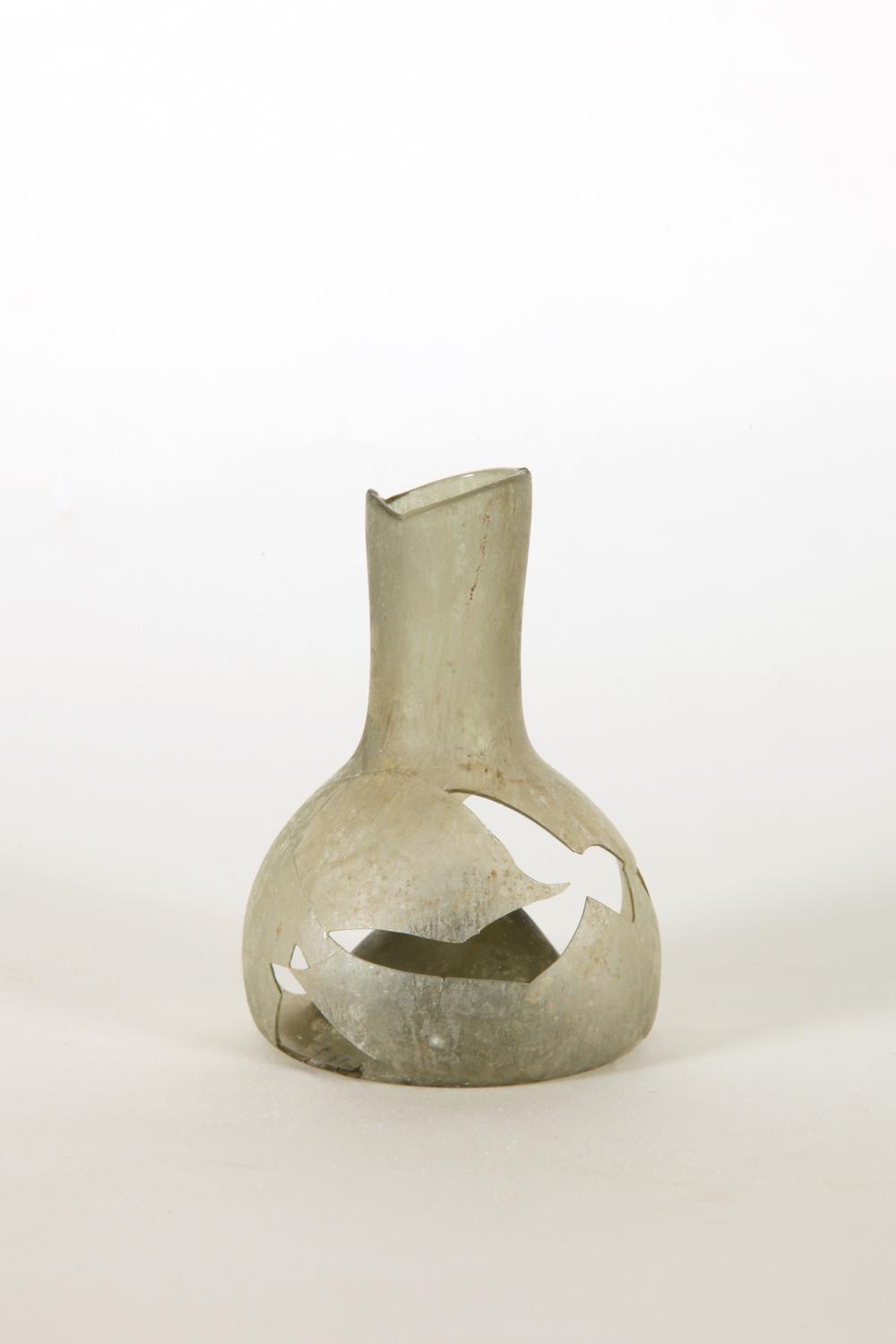
(18/ )
Modern period [1492 / 1789]
Small bottle with globular body flattened at its base. The bottom is deeply pushed back. The neck is wide and its edge is irregular. Important gaps.
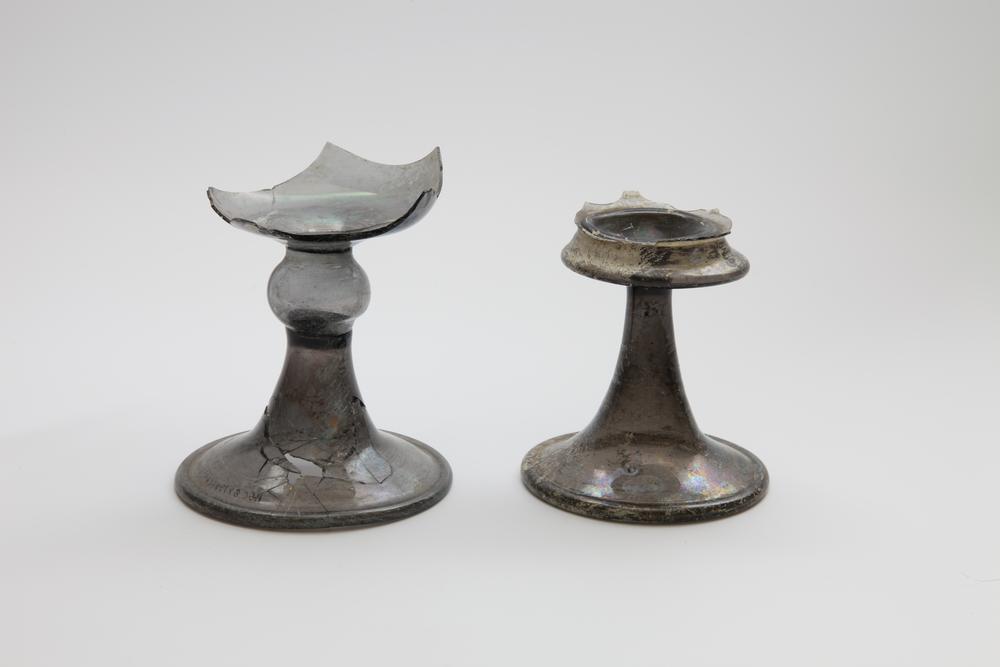
(19/ )
Modern period [1492 / 1789]
Grey blown glass (campaniform cut completely disappeared).
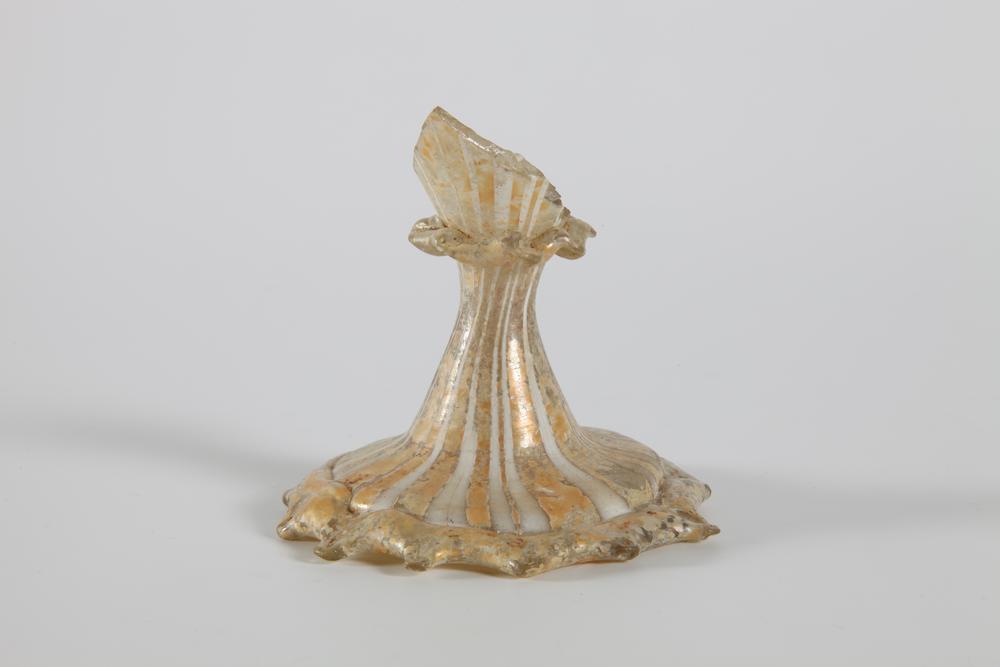
(20/ )
Modern period [1492 / 1789]
Stemmed glass with only the foot intact, in the form of a pavilion bordered by a scalloped rim. At the base of the body, which appears to be conical, there is a wavy bead. Three shards of the body are decorated with two horizontal lines and vertical oves in white vere. On the foot, the decoration of vertical white lines is included in the paste, alternating with the transparent paste. Glass "Venice style".
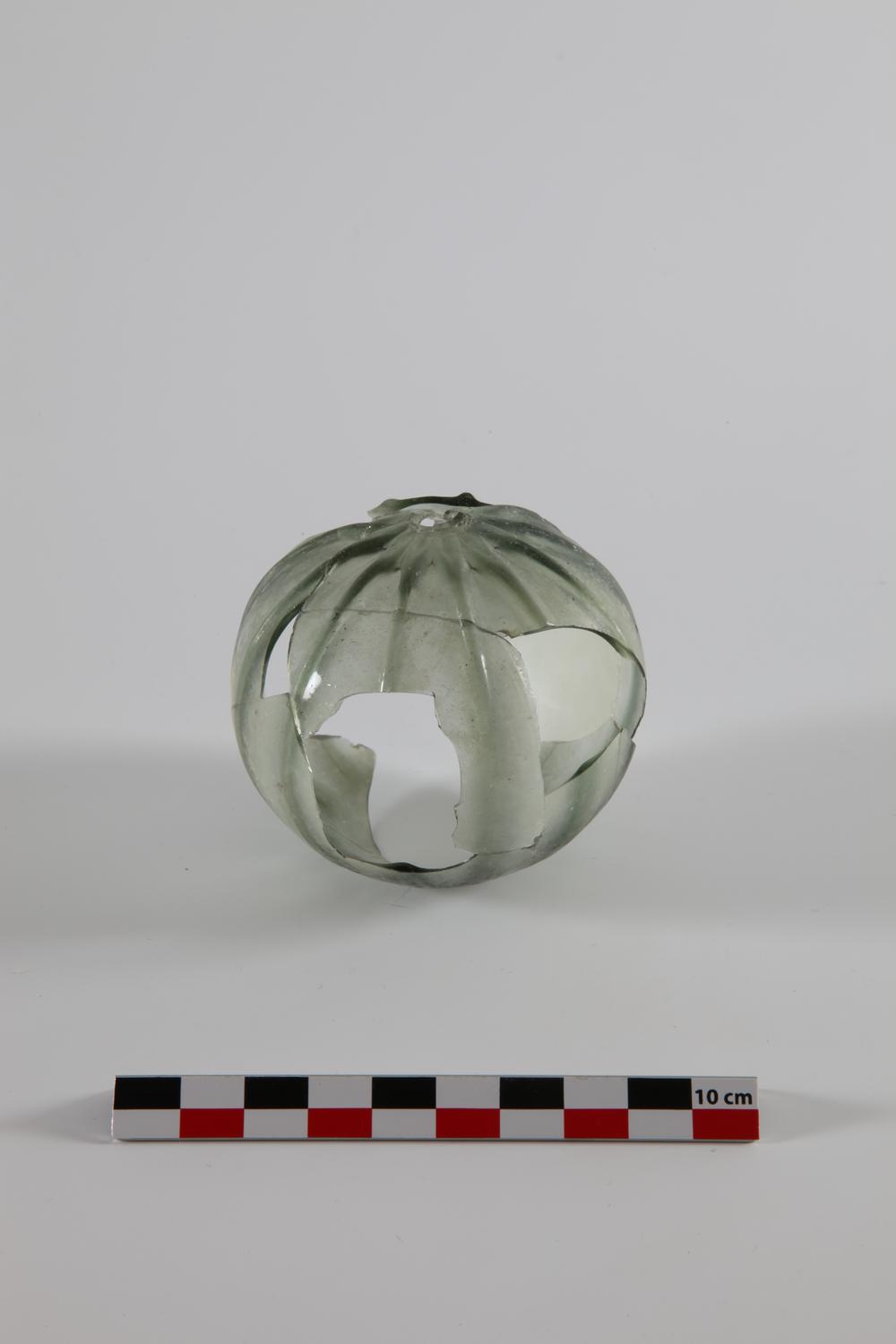
(21/ )
Modern period [1492 / 1789]
Blown glass molded with ribbed decoration. "The spherical shape of this object poses some difficulties in terms of identification. While several parallels are known, none has been found complete. It could be a perfume ball or the lower part of a vase crowned with a long, thin neck."

(22/ )
Modern period [1492 / 1789]
The body of a flattened globular flask with an umbilical bottom, decorated with vertical ribs starting from the base of the neck. The neck has disappeared.
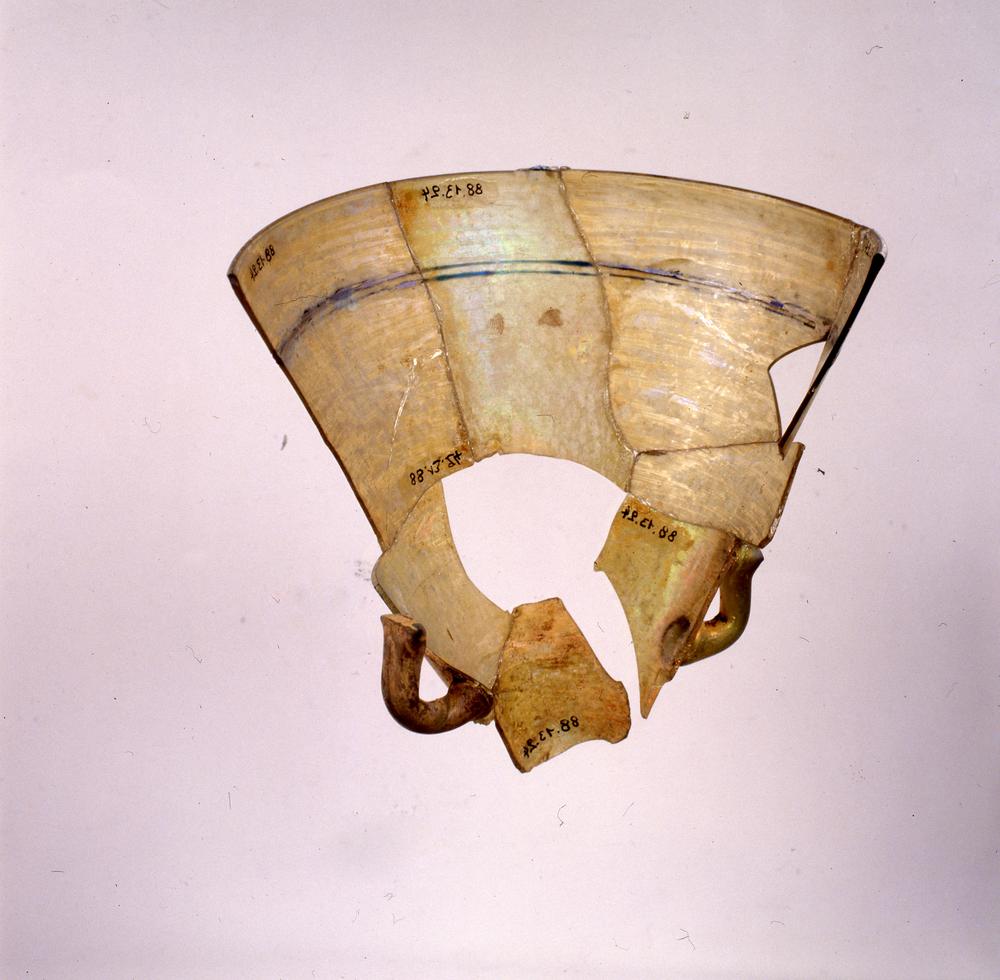
(23/ )
Modern period [1492 / 1789]
12 fragments of a glass (stemmed?) with a very high conical cut. Near the rim, two nets and at the base, two elements formed by ribbons of paste.
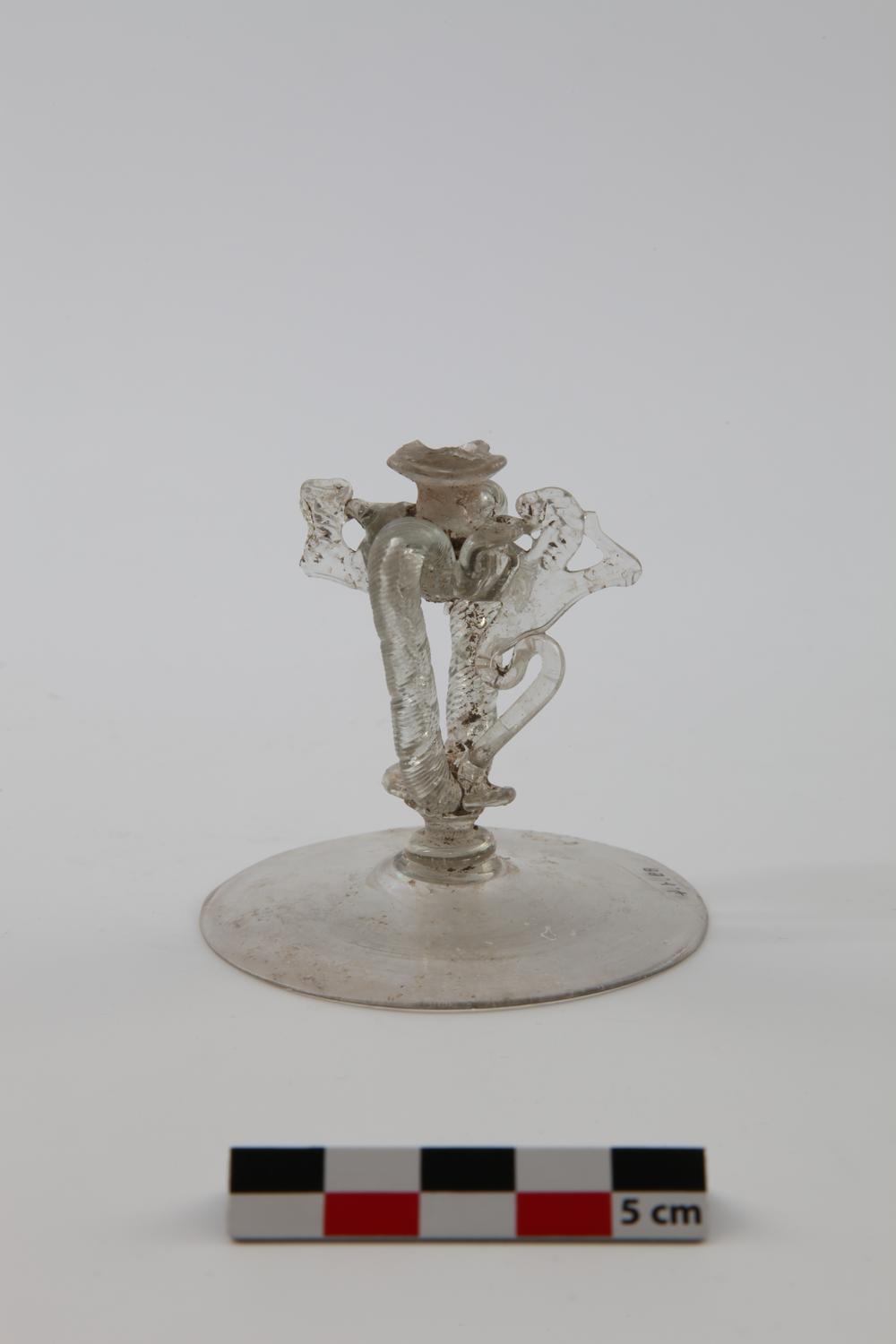
(24/ )
Modern period [1492 / 1789]
Glass foot with a circular base, whose stem is composed of two twists and two animal figures, resembling seahorses, opposed two by two. Above the stem, the glass is broken above a thin bead.

(25/ )
Modern period [1492 / 1789]
Moulded blown glass with enamelled decoration of oves, bridges and nets. Inscription "VS M Q J". Foot linked to the cup by a hollow fluted button.
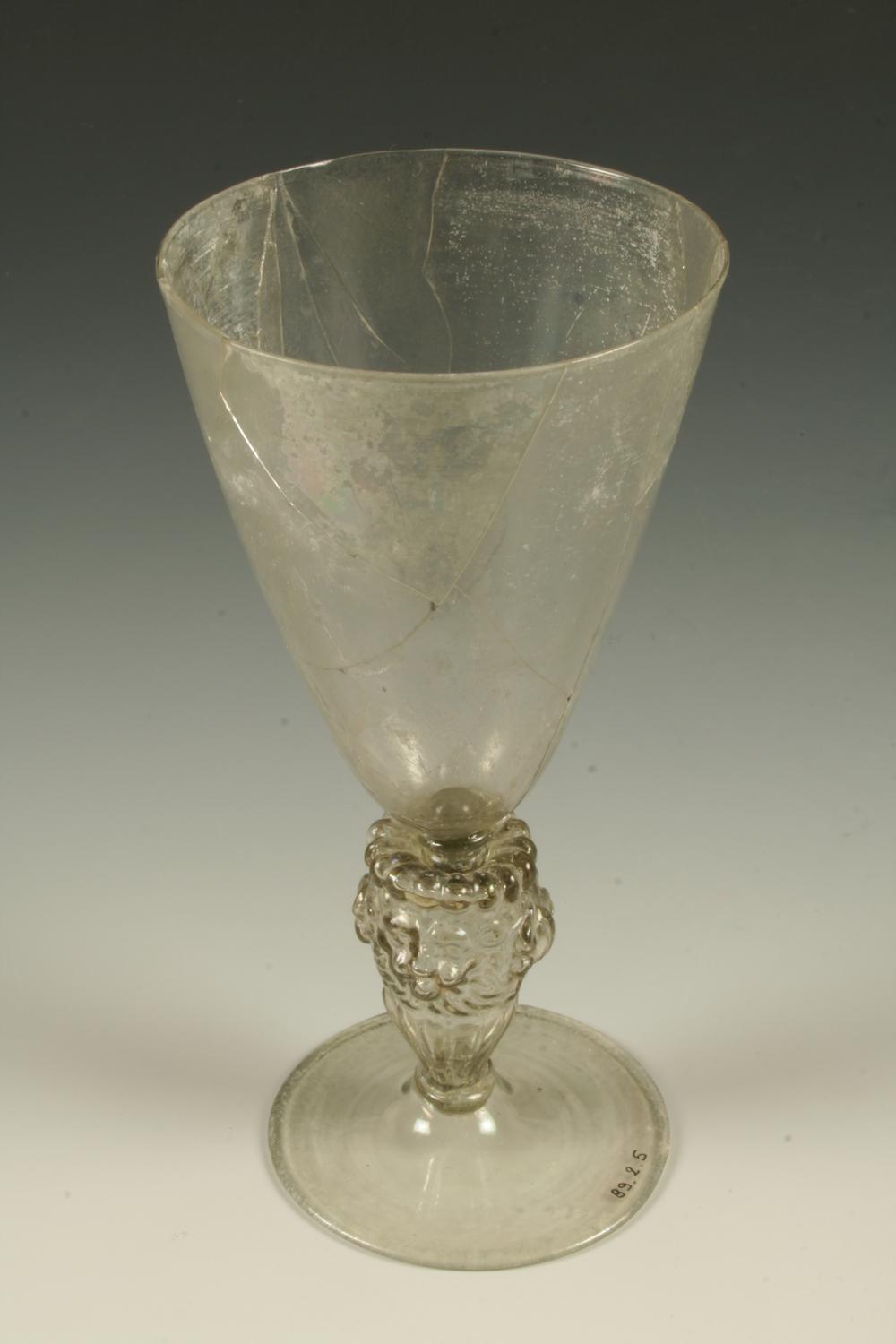
(26/ )
Modern period [1492 / 1789]
Campaniform glass with foot "way Venice" colorless blown molded. Inspired by Venetian productions, this glass is one of the most beautiful representatives of this emulation which gained workshops of Northern Europe and Italian workshops at the end of the Renaissance. This leg decorated with a hollow button molded to fit the features of a lion was very popular at the time, so much so that it was found on all the good European tables. The method of manufacture being based on several distinct gobs, it was possible to find above its legs cups of various forms.
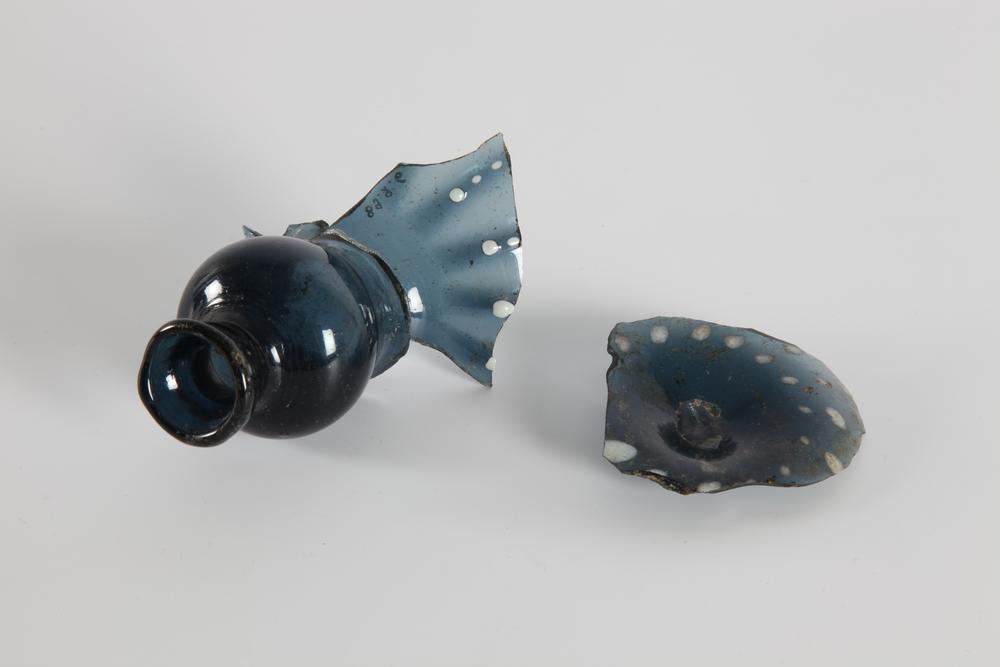
(27/ )
Modern period [1492 / 1789]
Bottle with spherical neck narrowing upwards. The bottom is slightly umbilical. The body seems to have been ribbed with white pastilles.
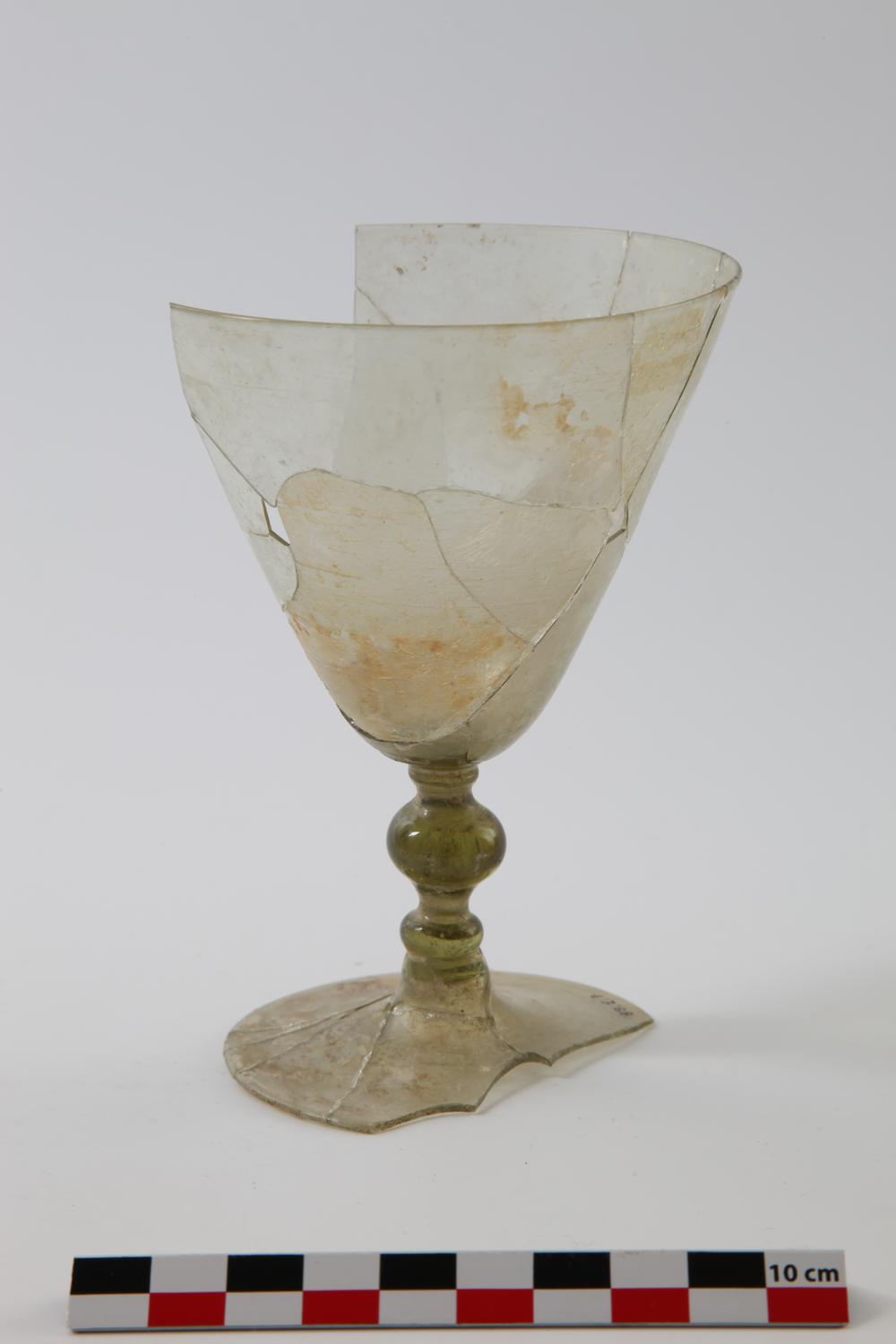
(28/ )
Modern period [1492 / 1789]
Campaniform glass with a colorless foot blown molded. Foot linked to the cup by a hollow ribbed button between two beads. "Of beautiful size, these drinking glasses were manufactured thanks to two or three distinct gobs before being assembled with heat. Testifying to a beautiful evolution of the glassmaking repertoire from the second half of the 16th century, the legs of these glasses are now the privileged support of an ornamentation often inspired by Venetian catalogs and sometimes completed by an enamelled decoration, of French inspiration."
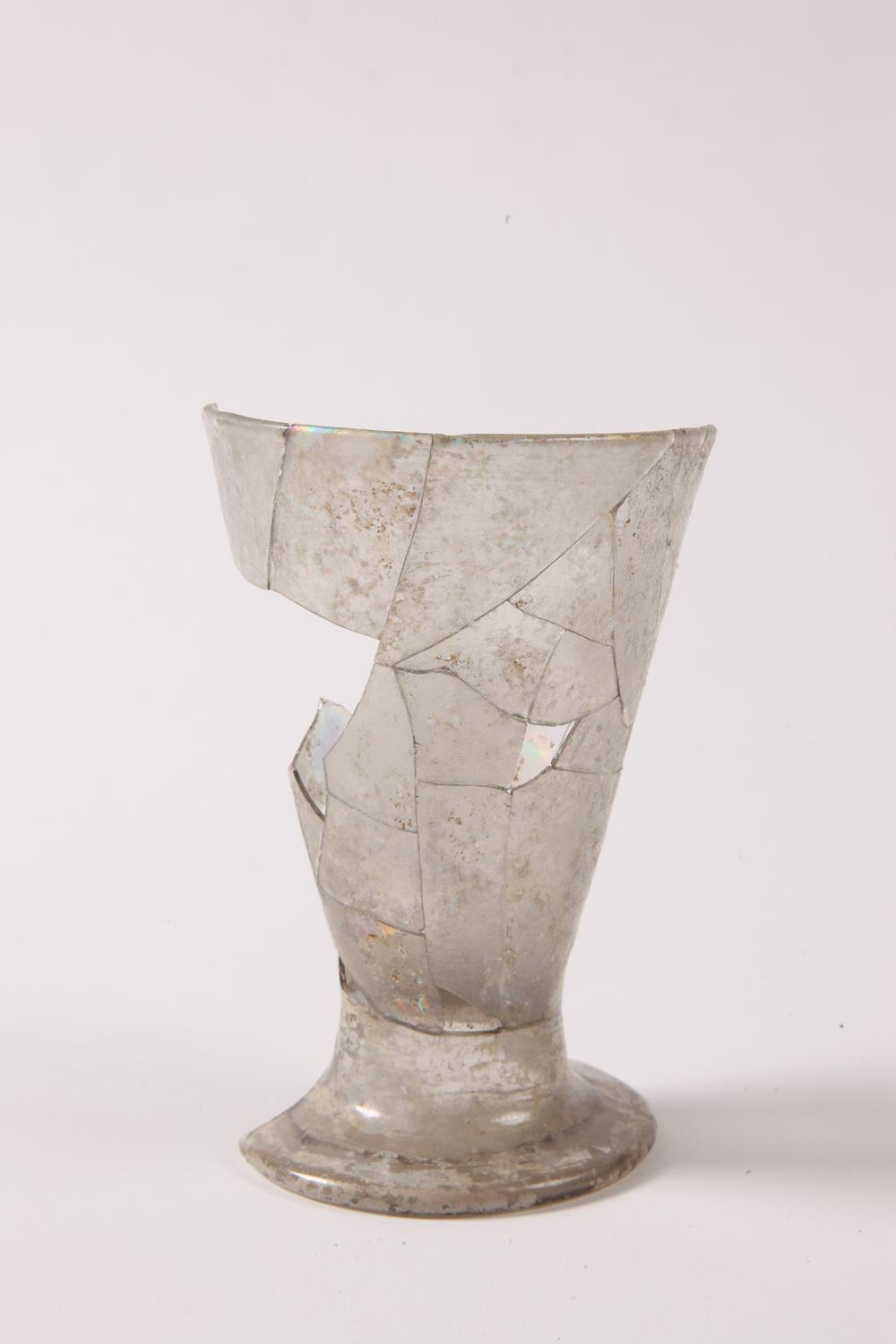
(29/ )
Modern period [1492 / 1789]
High cup with truncated conical cut on pedestal.
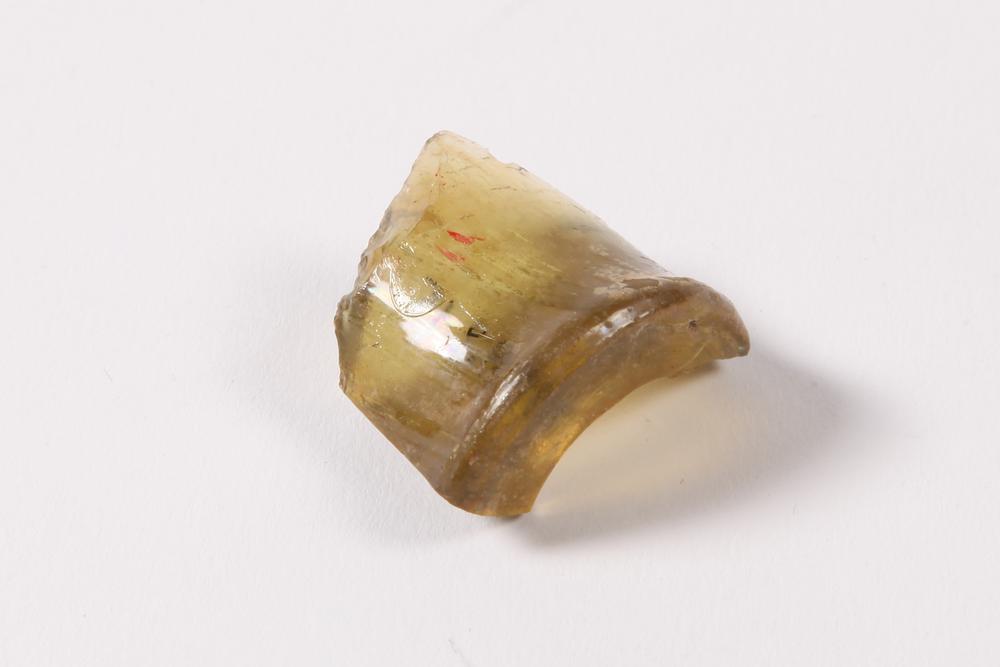
(30/ )
Modern period [1492 / 1789]
Bottle in the shape of parallellepiped narrowing towards the base. The bottom is umbilical. The shoulder is very marked. The cylindrical neck has a flat edge slightly everted. A part of the body and the top of the neck are missing.
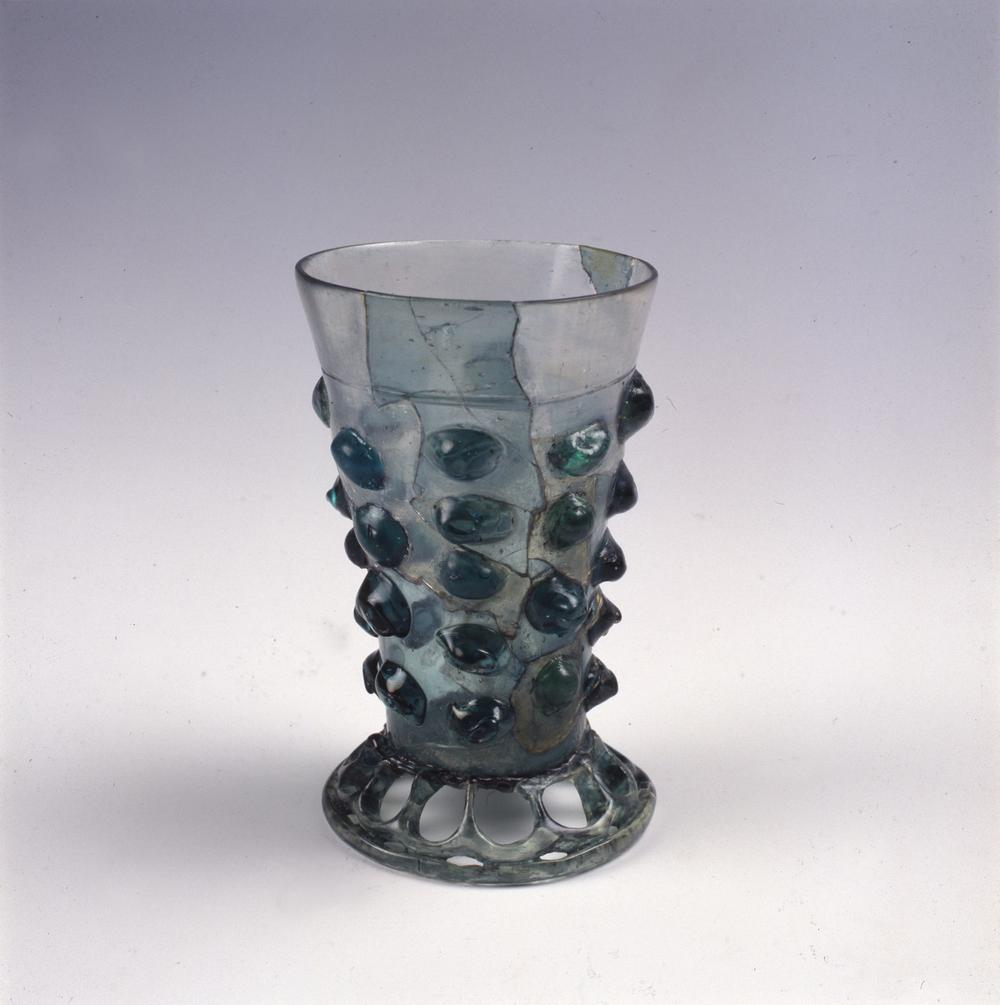
(31/ )
Modern period [1492 / 1789]
Blown glass with decoration of blue glass pastilles. Pedestal formed of glass threads.
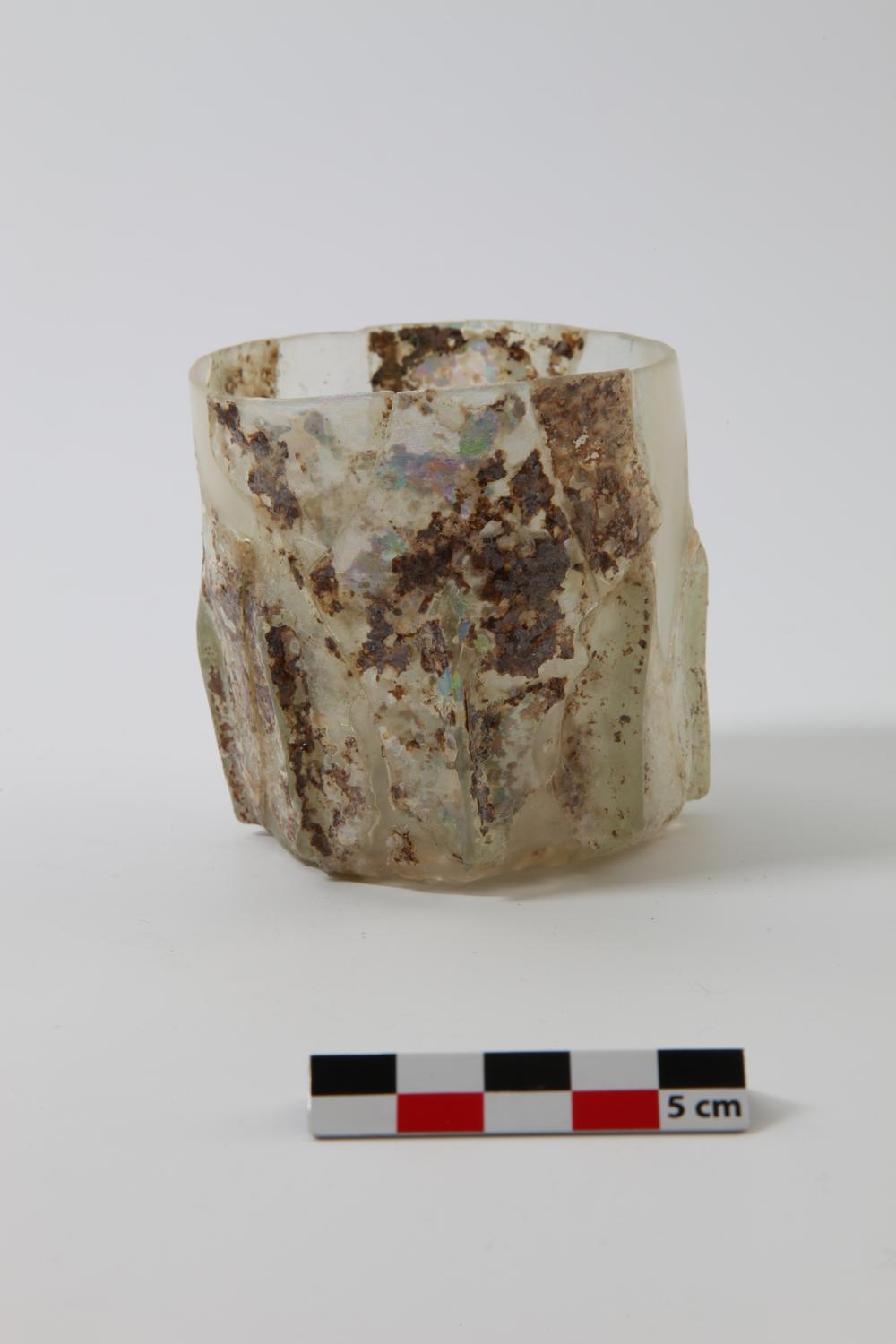
(32/ )
Modern period [1492 / 1789]
Goblet with ribbed body and umbilical bottom, greenish white color, very oxidized.

(33/ )
Modern period [1492 / 1789]
Cylindrical cup with 8 very prominent vertical ribs in the lower half of the body. Bottom in omblic.
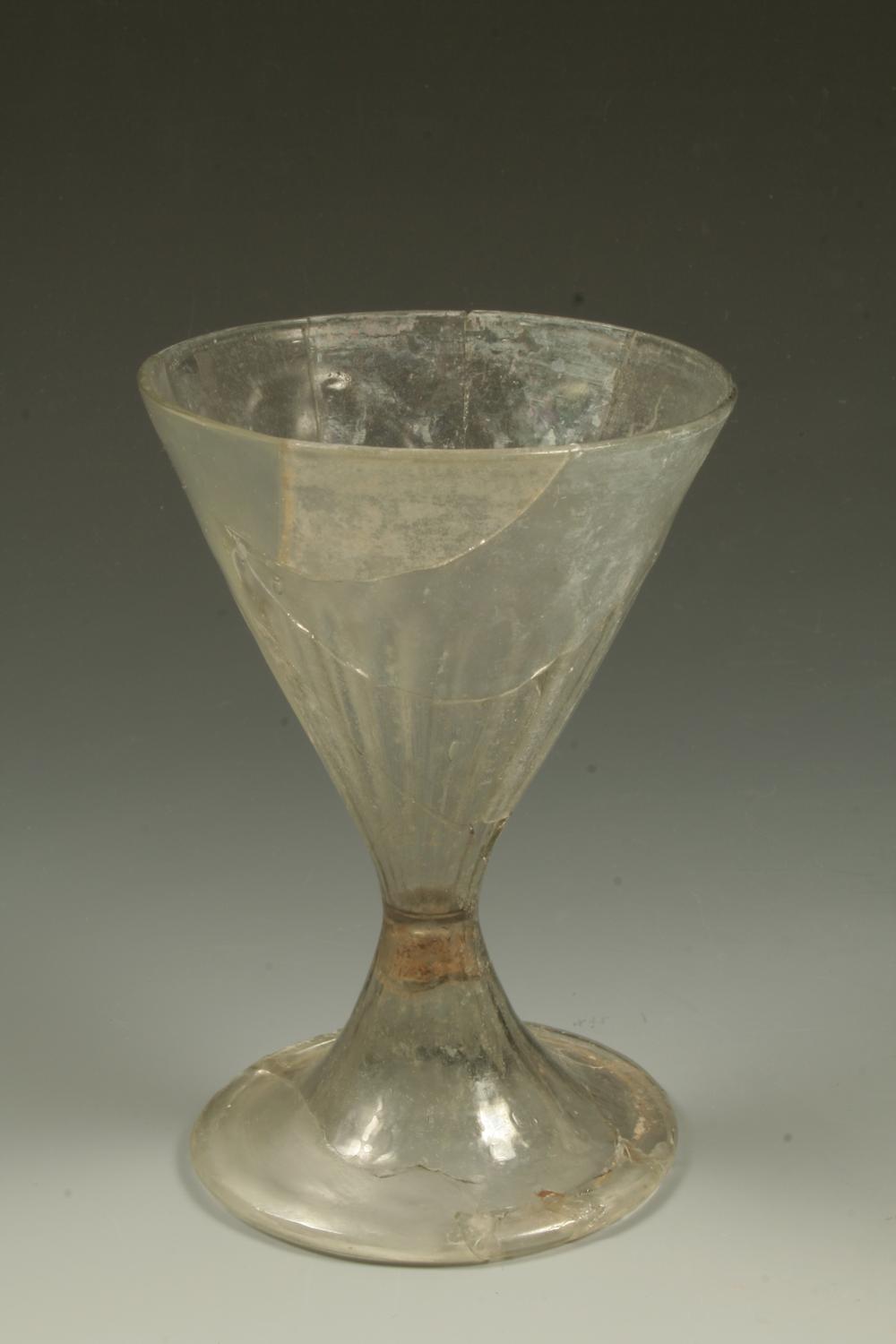
(34/ )
Modern period [1492 / 1789]
Moulded blown glass with ribbed and embossed decoration. Upside down foot.
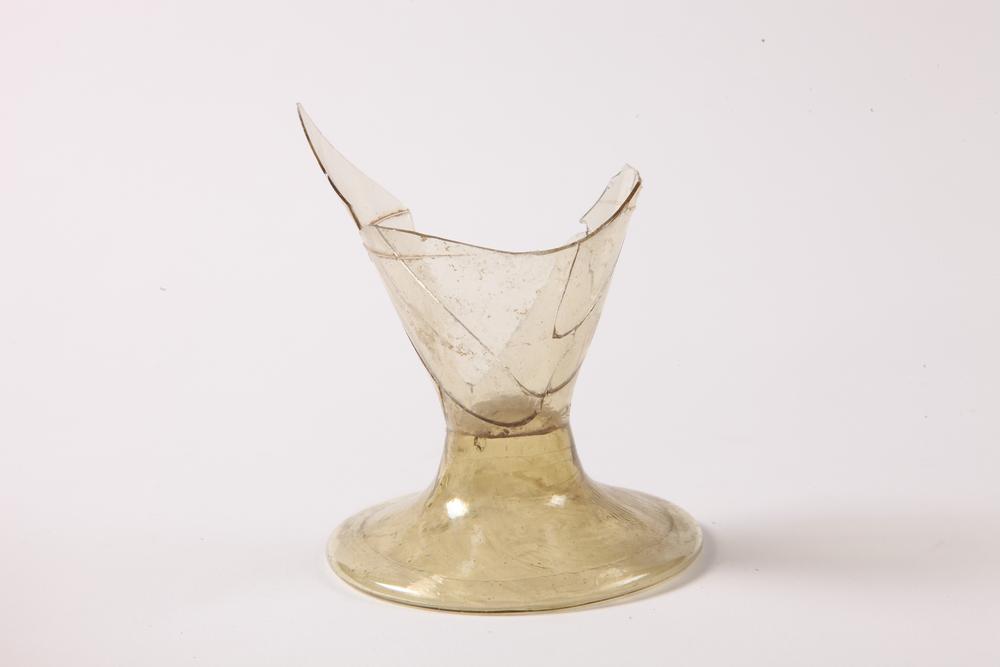
(35/ )
Modern period [1492 / 1789]
Glass with bitronconic foot whose glass is blown with thin net of glass added. Foot turned up.
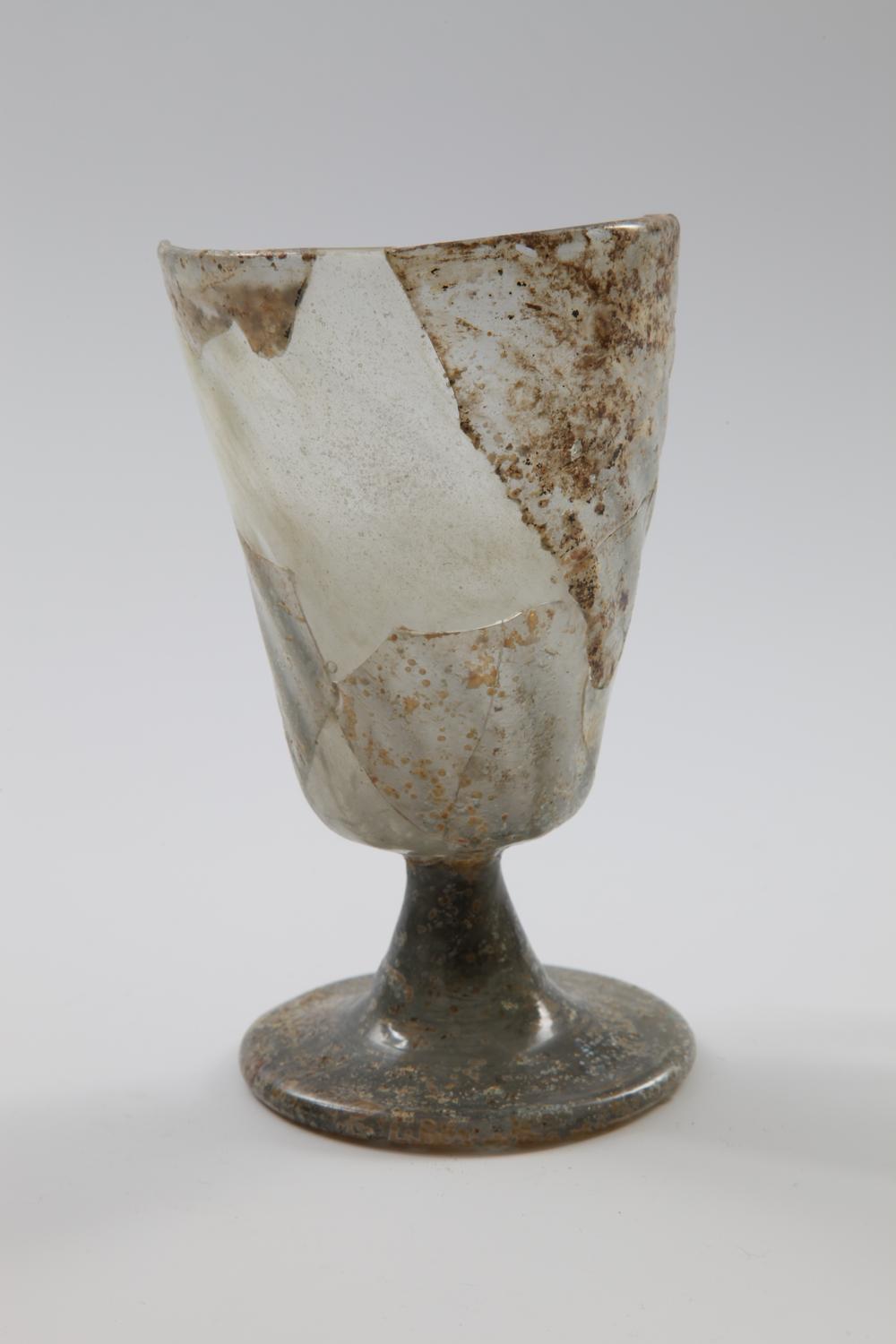
(36/ )
Modern period [1492 / 1789]
Grayish glass blown molded with decoration of twisted ribs. Foot pushed back.
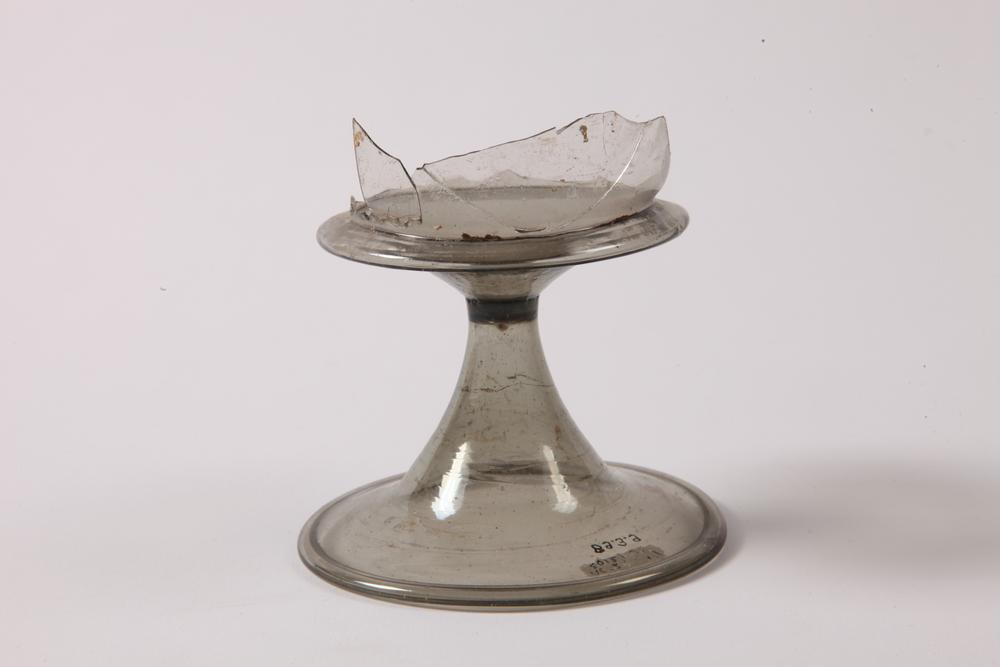
(37/ )
Modern period [1492 / 1789]
Glass with foot. The truncated conical cup, very thin, is decorated at its base with a hollow ring largely overflowing. The conical foot has a hemmed edge. We can see traces of pointil. The bowl is very fragmented with important gaps.
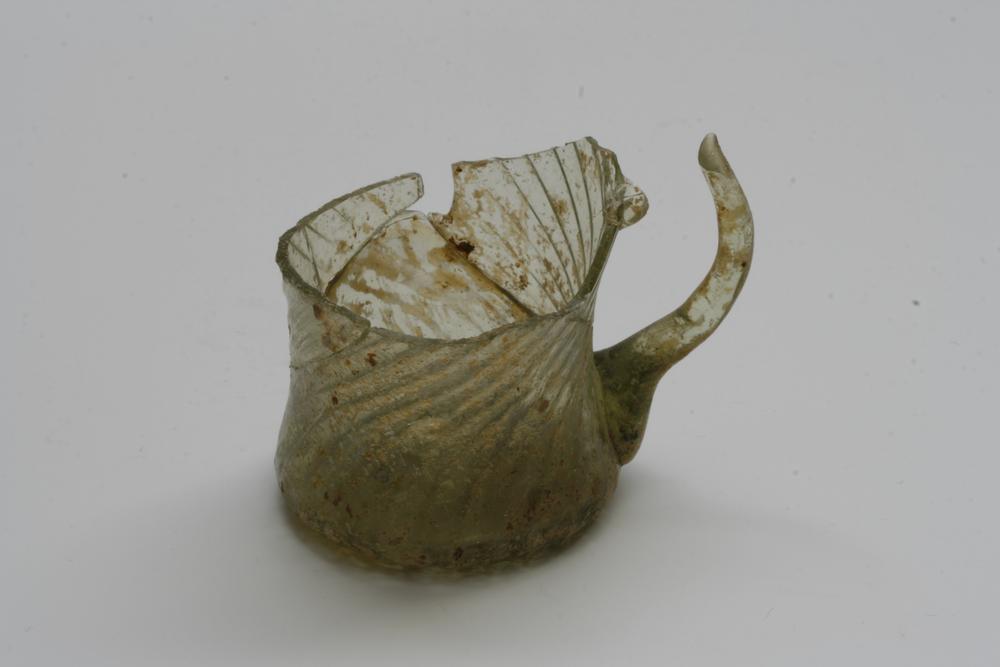
(38/ )
Modern period [1492 / 1789]
Glass blown with decoration of fine twisted ribs, umbilical bottom and handle. (The upper part of the cup is missing).
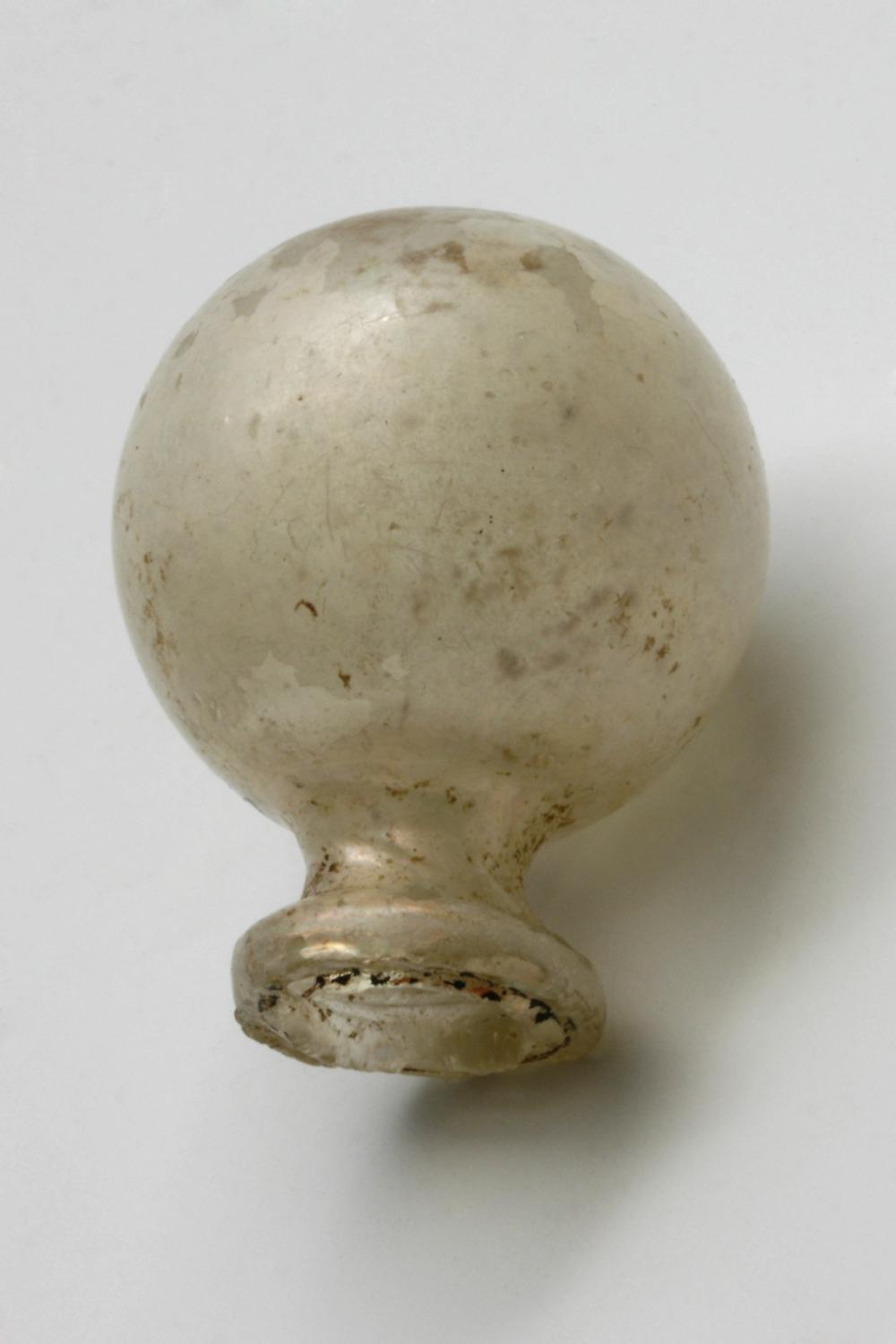
(39/ )
Modern period [1492 / 1789]
Hollow ball mounted on a "ring" with traces of tearing. Probably a knob to hold a lid.
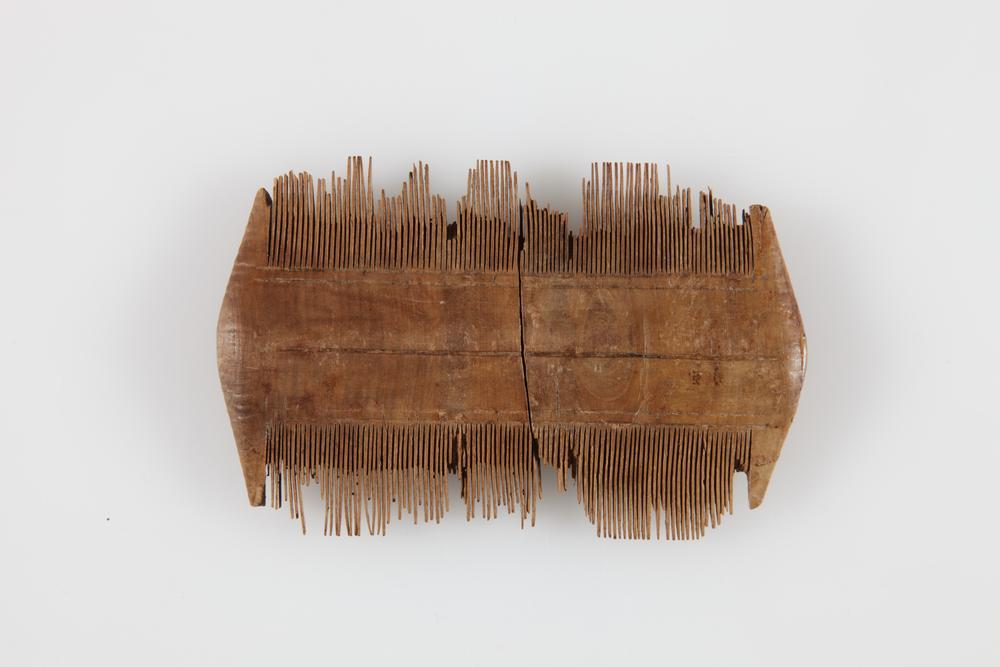
(40/ )
Gallo-Roman [- 50 / 476]
Fine comb with double teeth. The two ends end in a point towards the outside. An engraved decoration of straight lines appears on the central part of the object.
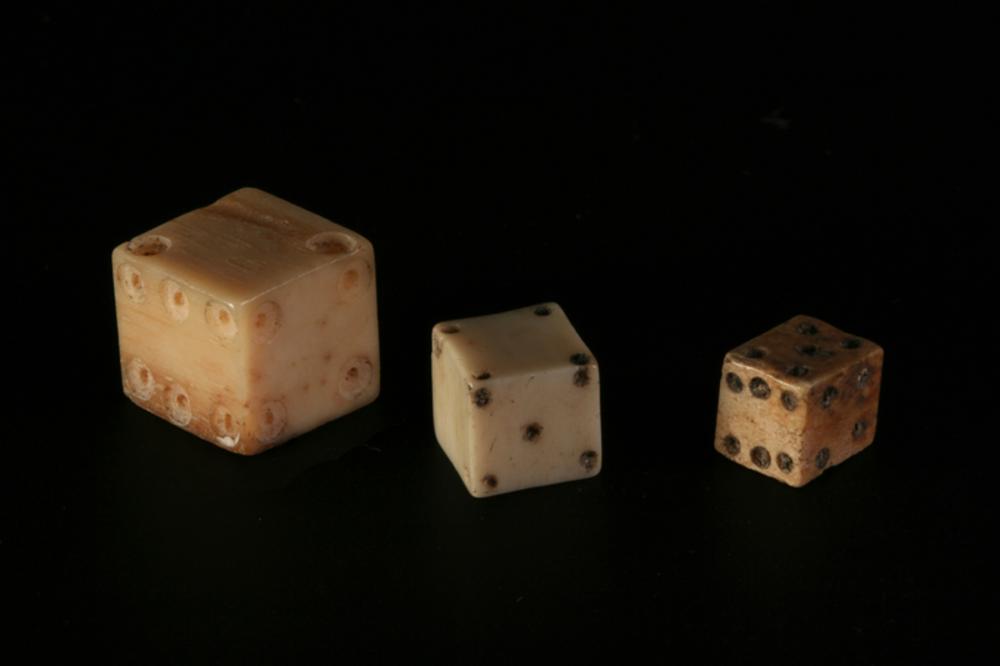
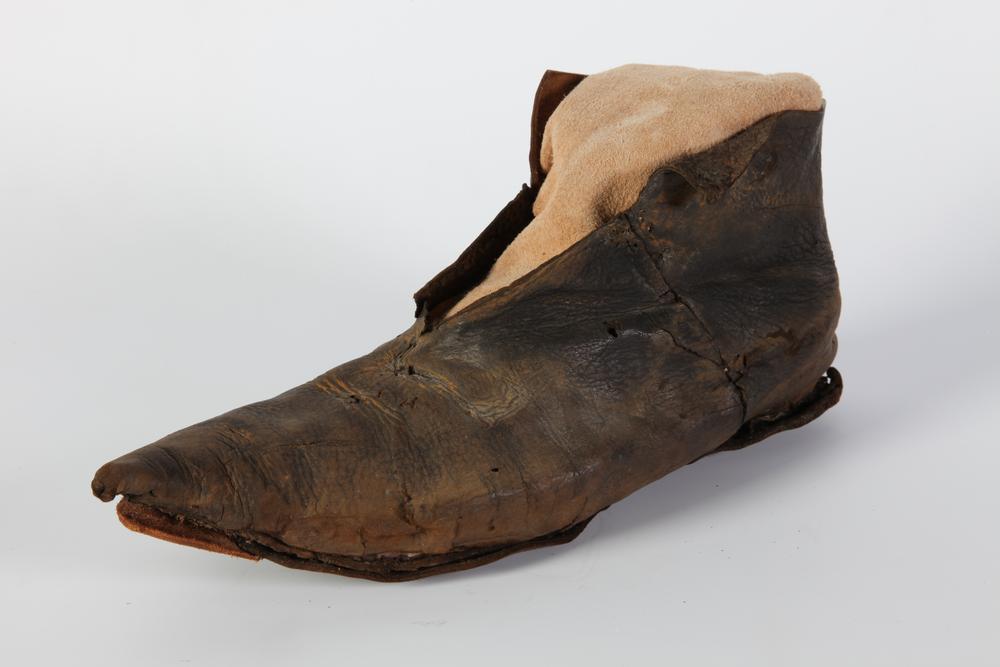
(42/ )
Modern period [1492 / 1789]
High shoe reaching the malleoli, composed of five elements and a sole, initially closed by two buckles on the vamp and the half-quarter (disappeared).
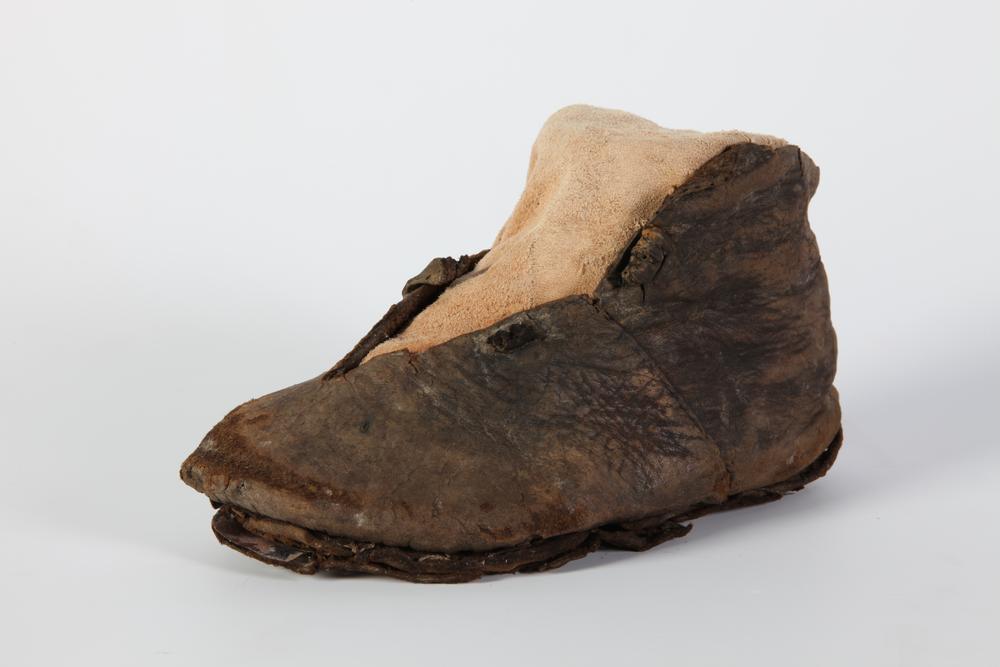
(43/ )
Modern period [1492 / 1789]
Left shoe of child, closed by two buckles (disappeared) on the forefoot. Reaching the malleoli, this high shoe was composed of six elements (vamp, two half quarters, tongue and strap -disappeared-, counter).

(44/ )
Modern period [1492 / 1789]
Straight shoe for children closed by lacing on the forefoot. Upper made of one piece closed by a side seam. Back reinforced by a counter. Closure by lacing on the front of the foot. The sole is made according to the principle of sandalette sewing.
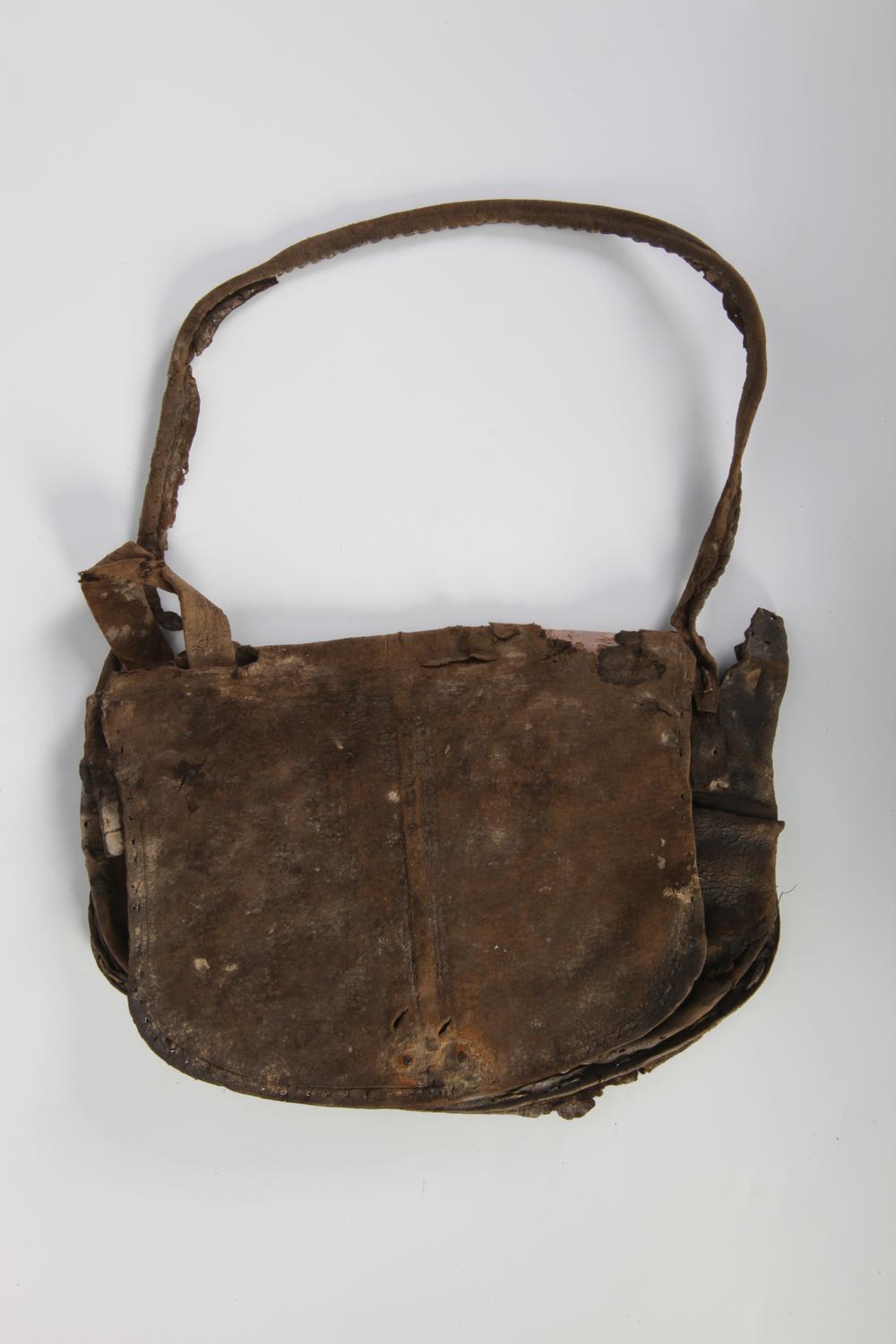
(45/ )
Modern period [1492 / 1789]
Aumonière composed of nine leather elements: the back and its lining, a flap, a front plate in the shape of a crescent with truncated points, two small triangles with truncated points mounted on the front plate, an insert between these two pieces, a saddle edge and a piping. The decoration consists of four parallel lines delimiting a central rib on the flap. A metal clip allowed the closure.
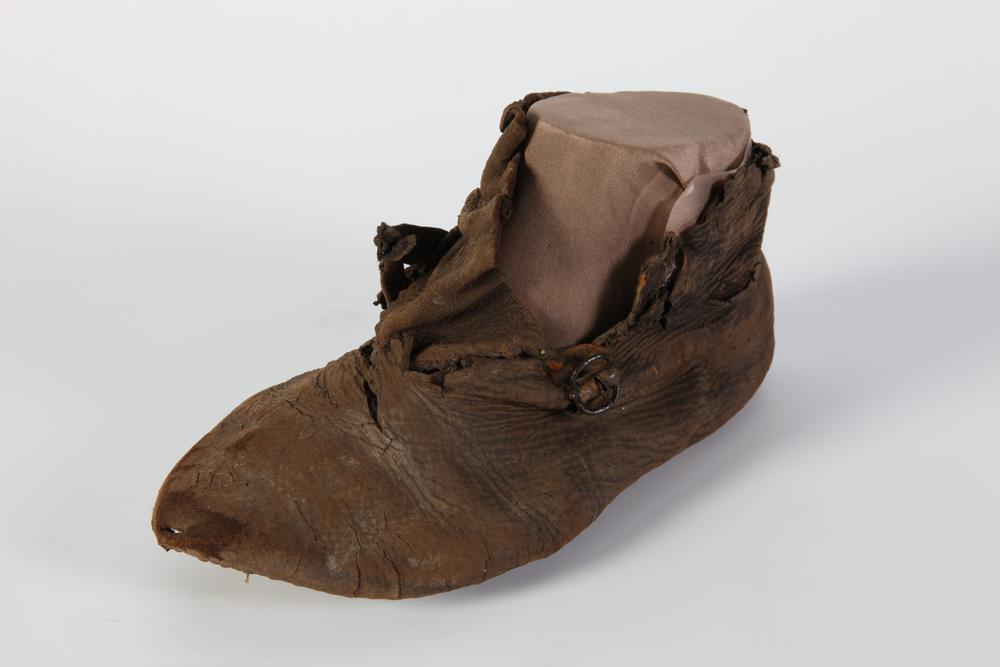
(46/ )
Modern period [1492 / 1789]
Complete left shoe, with opening on the forefoot, composed of nine elements: the upper, a triangular piece, a strap, a counter, two buckles with their buckle holder (one buckle disappeared), two straps (one disappeared), a tongue.
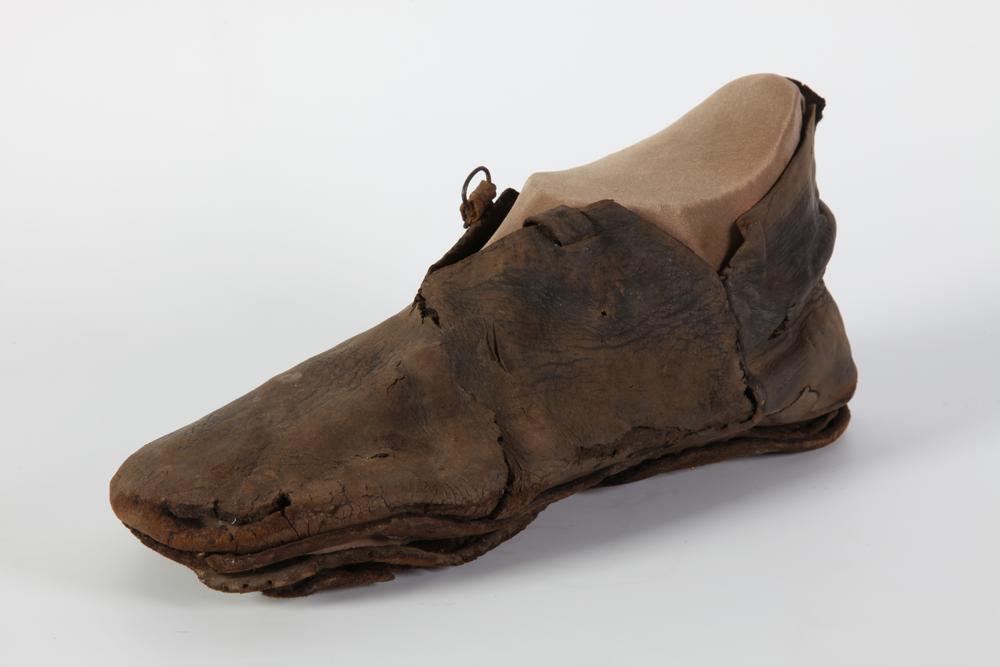
(47/ )
Modern period [1492 / 1789]
Low shoe opened on the forefoot, closed by a system of buckling on the slap. The skate, part of the quarter and the strap are missing. The buckle in 8 is preserved.

(48/ )
Modern period [1492 / 1789]
Whistle in the shape of a rider covered with a white slip. The head of the character, probably a page, is missing. He is wearing gloves, a pourpoint with gouged sleeves and bloomers. A perforation is visible under the right armpit and in place of the horse's tail. A trace of glaze is visible on the right front leg of the horse.

(49/ )
Modern period [1492 / 1789]
Figurine of a boar whose legs and part of the muzzle are missing. The back is arched and the fleece is represented by short incisions. The green glaze covers the body except for the rear part.
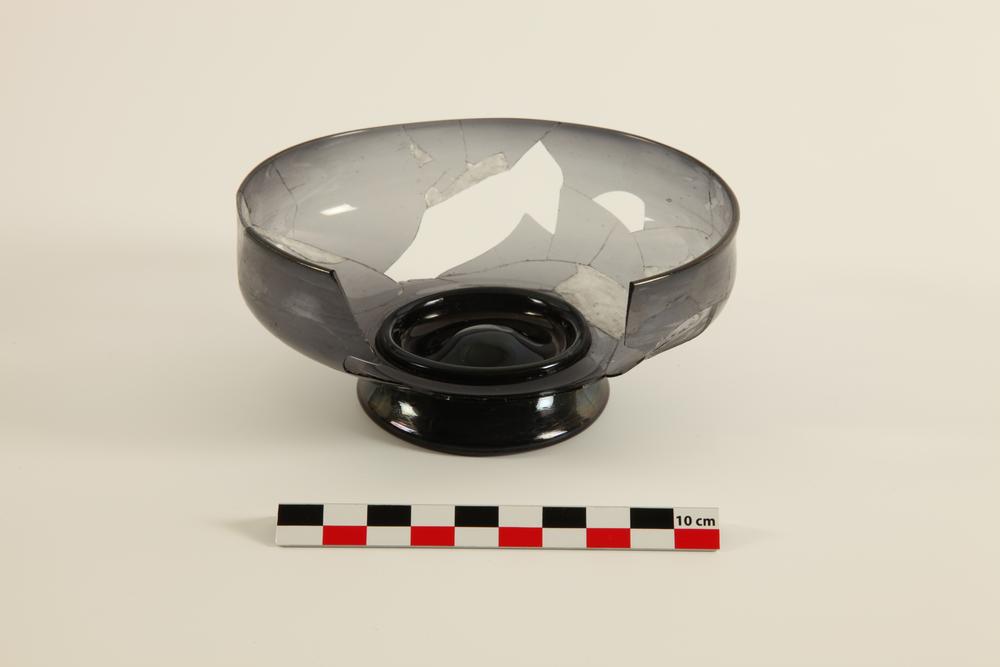
(50/ )
Modern period [1492 / 1789]
Molded black blown glass, upside down foot.
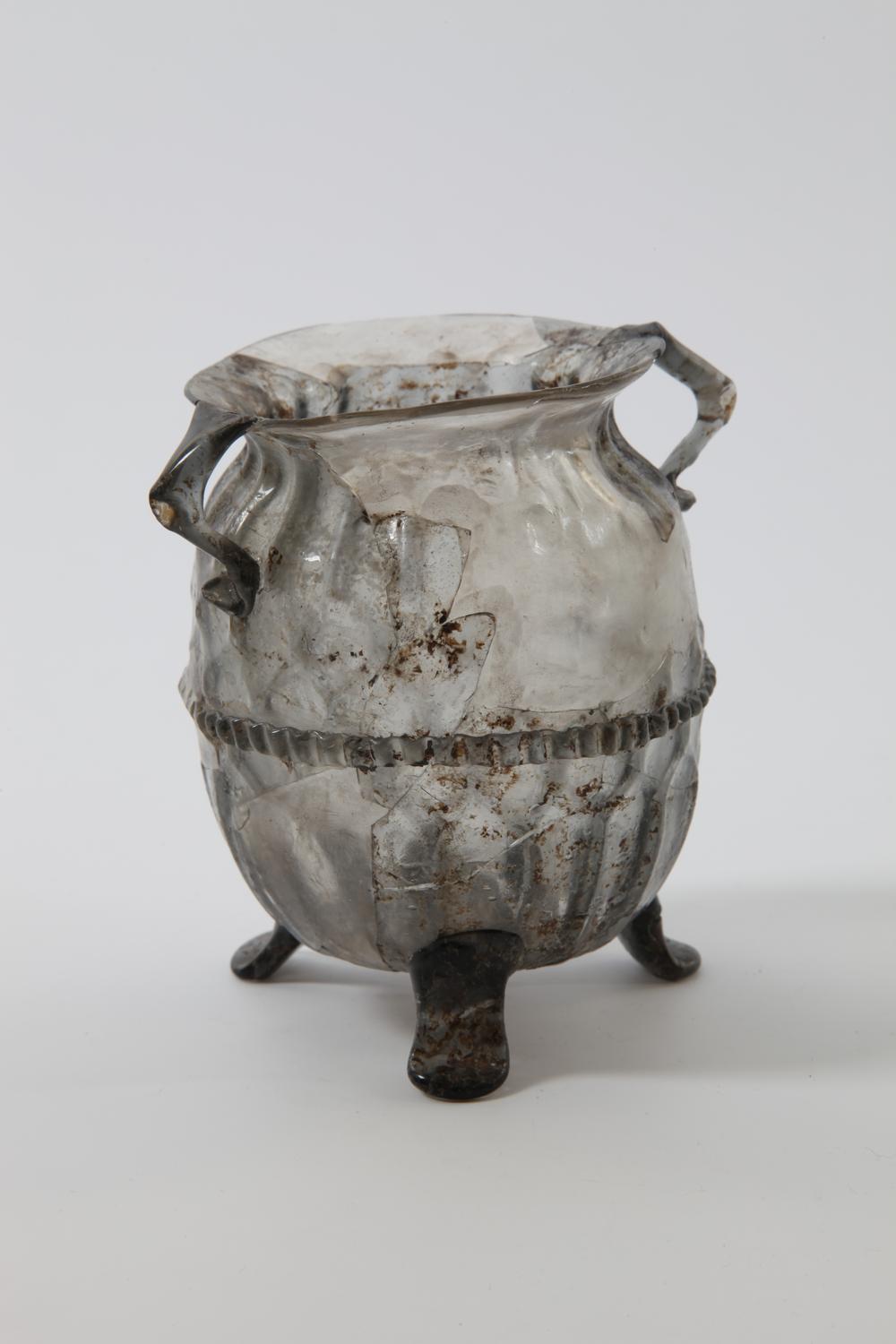
(51/ )
Modern period [1492 / 1789]
Moulded blown glass with ribbed decoration and pinched horizontal cord. Feet and handles are attached and worked with tongs. "Usually made of terracotta, tripods are pots with three feet to be stable when placed in the fireplace. Their transposition into glass poses all the more of a question as it is rare: only a few examples have been discovered in Metz, only one is known in Germany." (Archaeology and uses of glass, p.99).
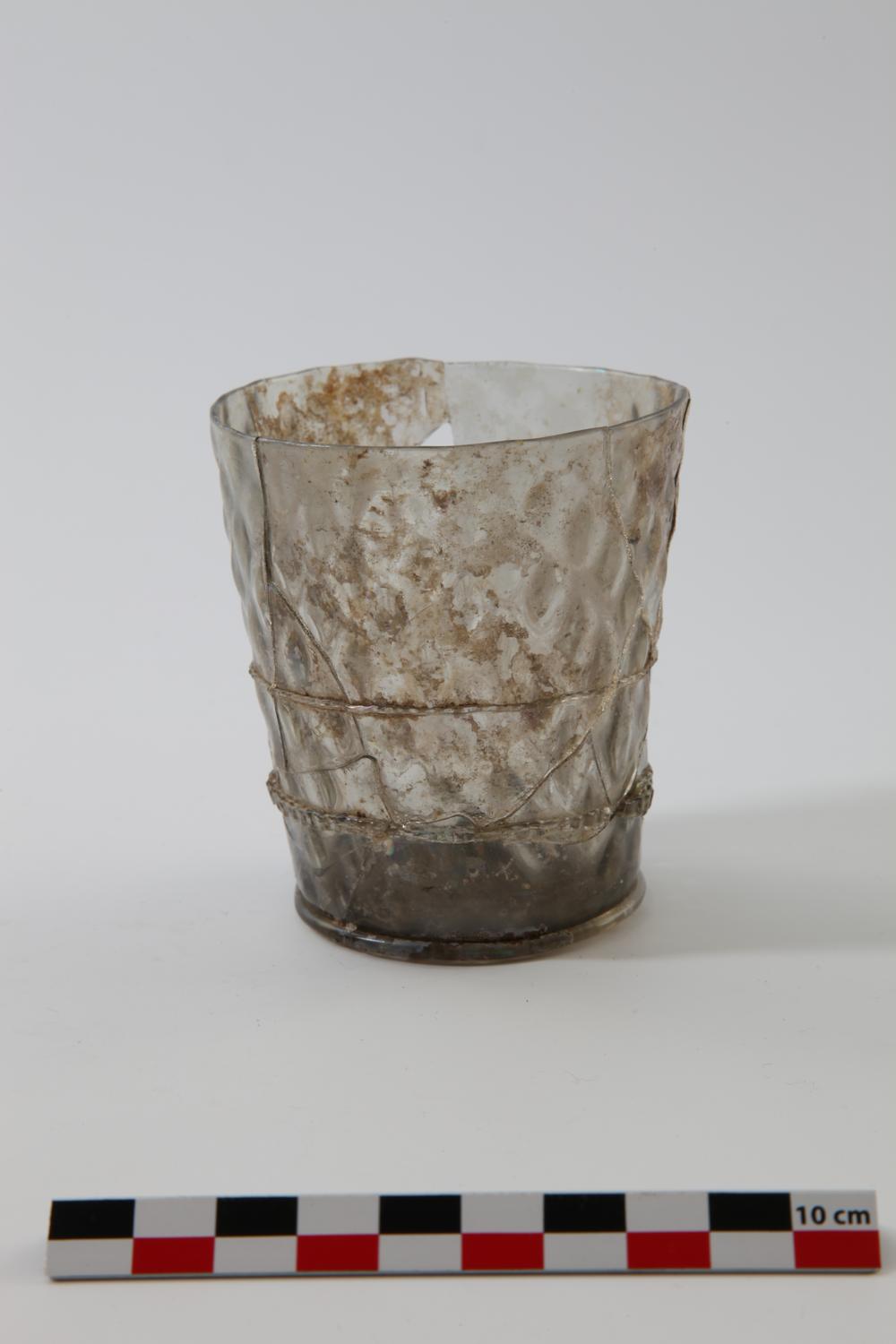
(52/ )
Modern period [1492 / 1789]
Glass blown molded with decoration of rhombuses and nets worked with the brush. The bottom is underlined by a glass cord.
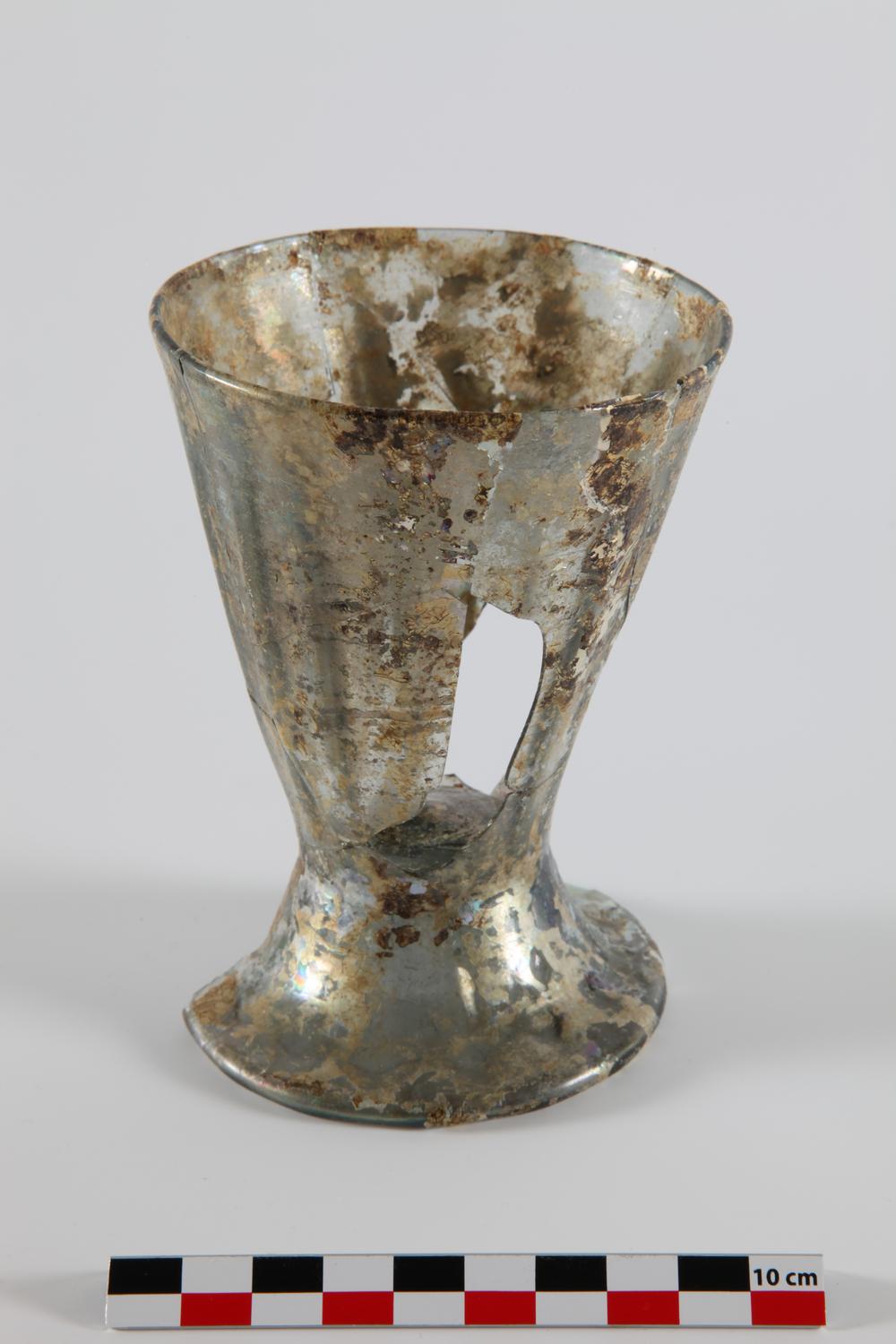
(53/ )
Modern period [1492 / 1789]
Moulded blown glass with vertical ribs. Foot pushed back.
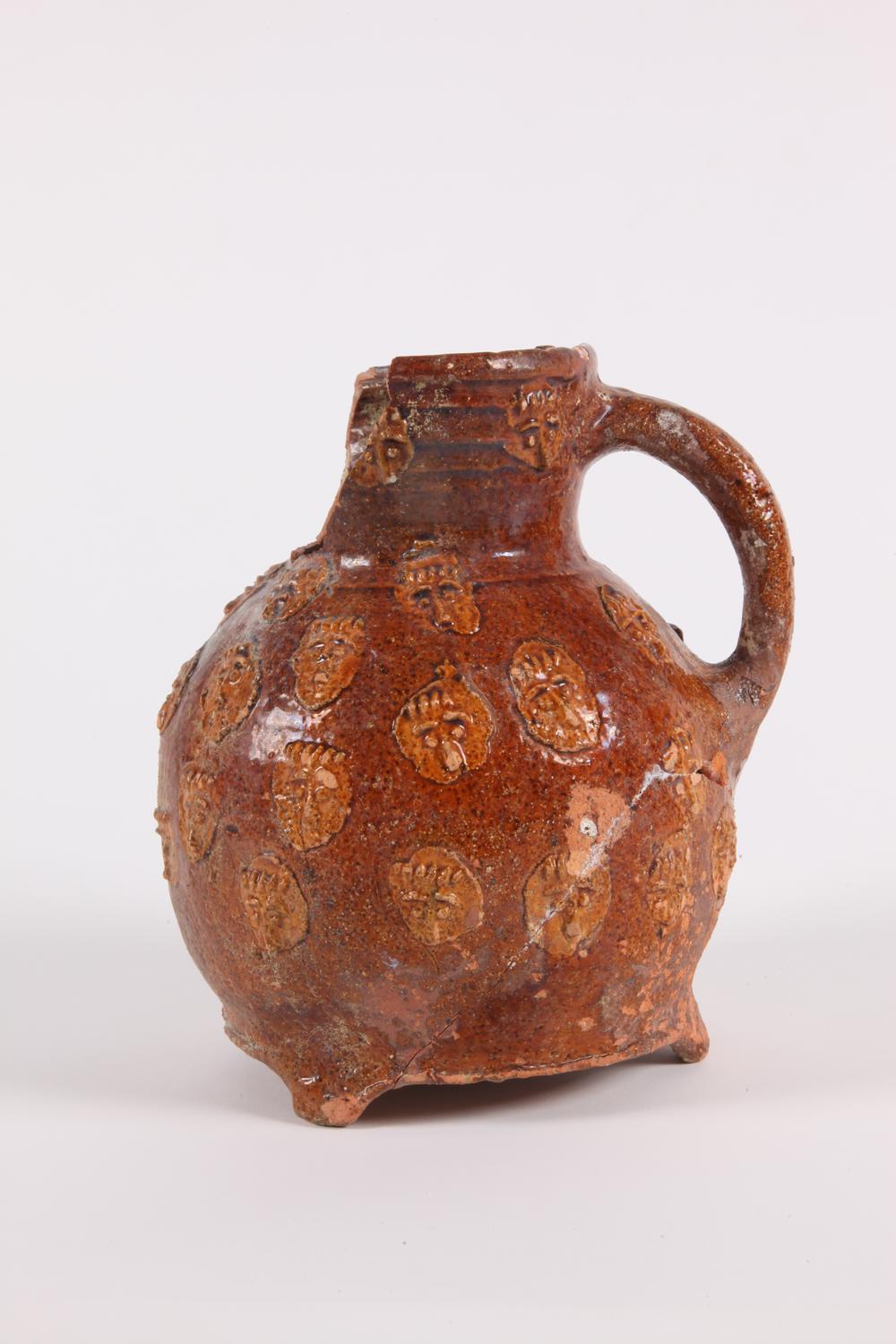
(54/ )
Middle Ages [476 / 1492]
Pitcher with oval body (maximum diameter in its center). Neck slightly flared, round handle attached to the body above its maximum diameter. Pinched foot.
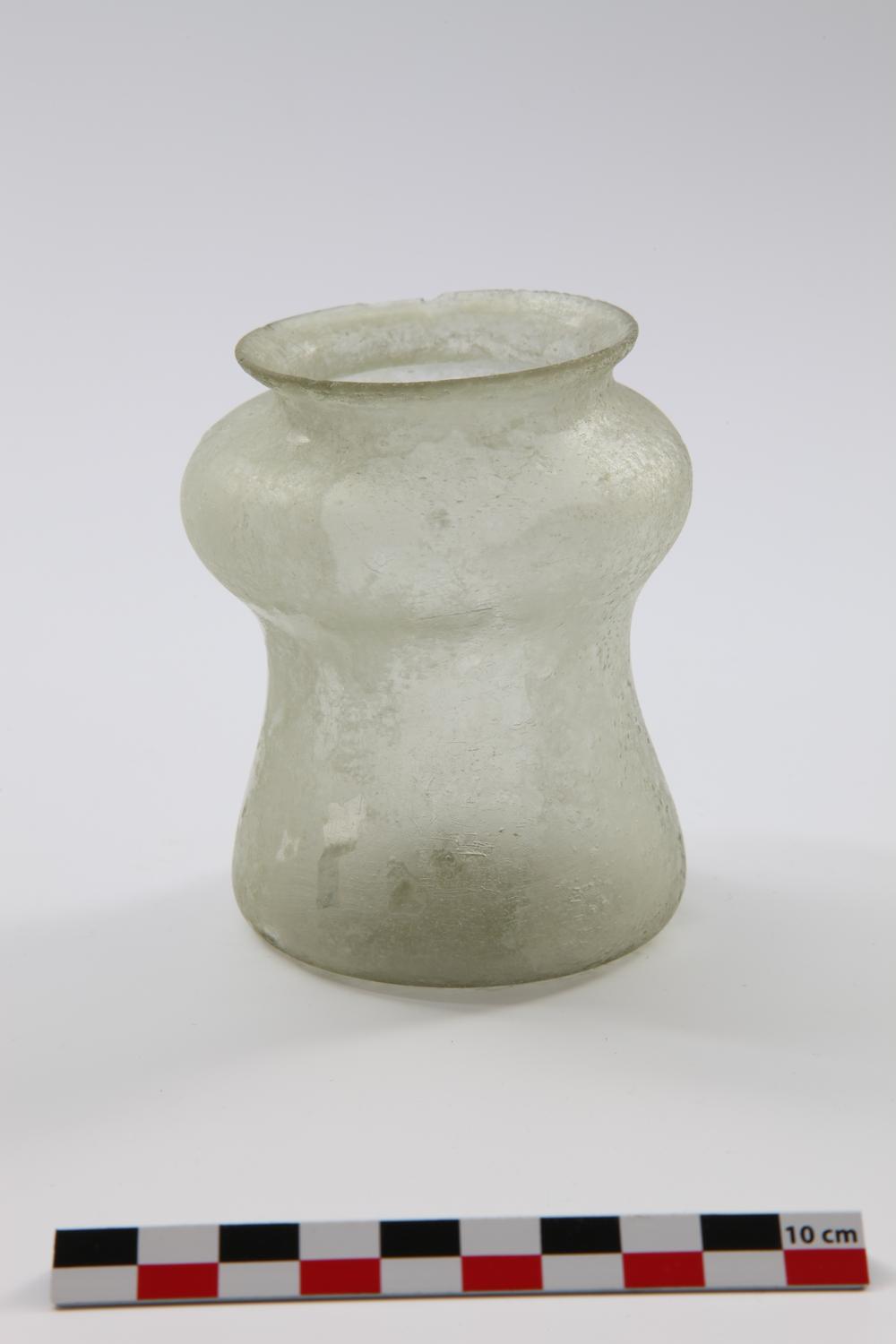
(55/ )
Modern period [1492 / 1789]
Glass container of cylindrical form constricted in its median part. The upper part is everted.

(56/ )
Modern period [1492 / 1789]
Cup in blown glass, linked to the foot by a hollow ribbed button.

(57/ )
Classical Middle Ages [1000/ 1300]
Goblet with decoration of straight ribs taken up with the clip at their lower ends.
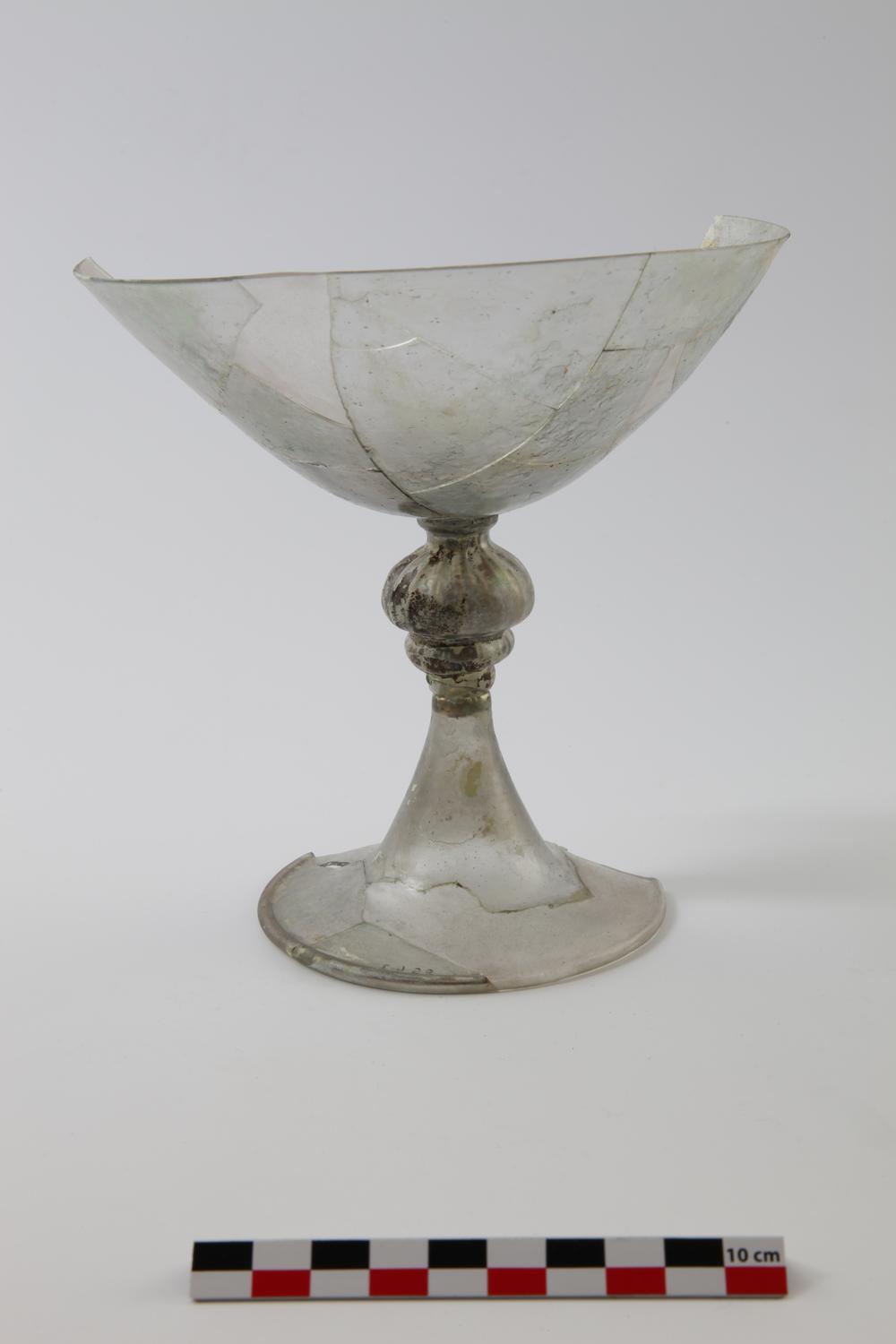
(58/ )
Modern period [1492 / 1789]
Blown glass bowl, linked to the foot by a hollow ribbed button and two beads.
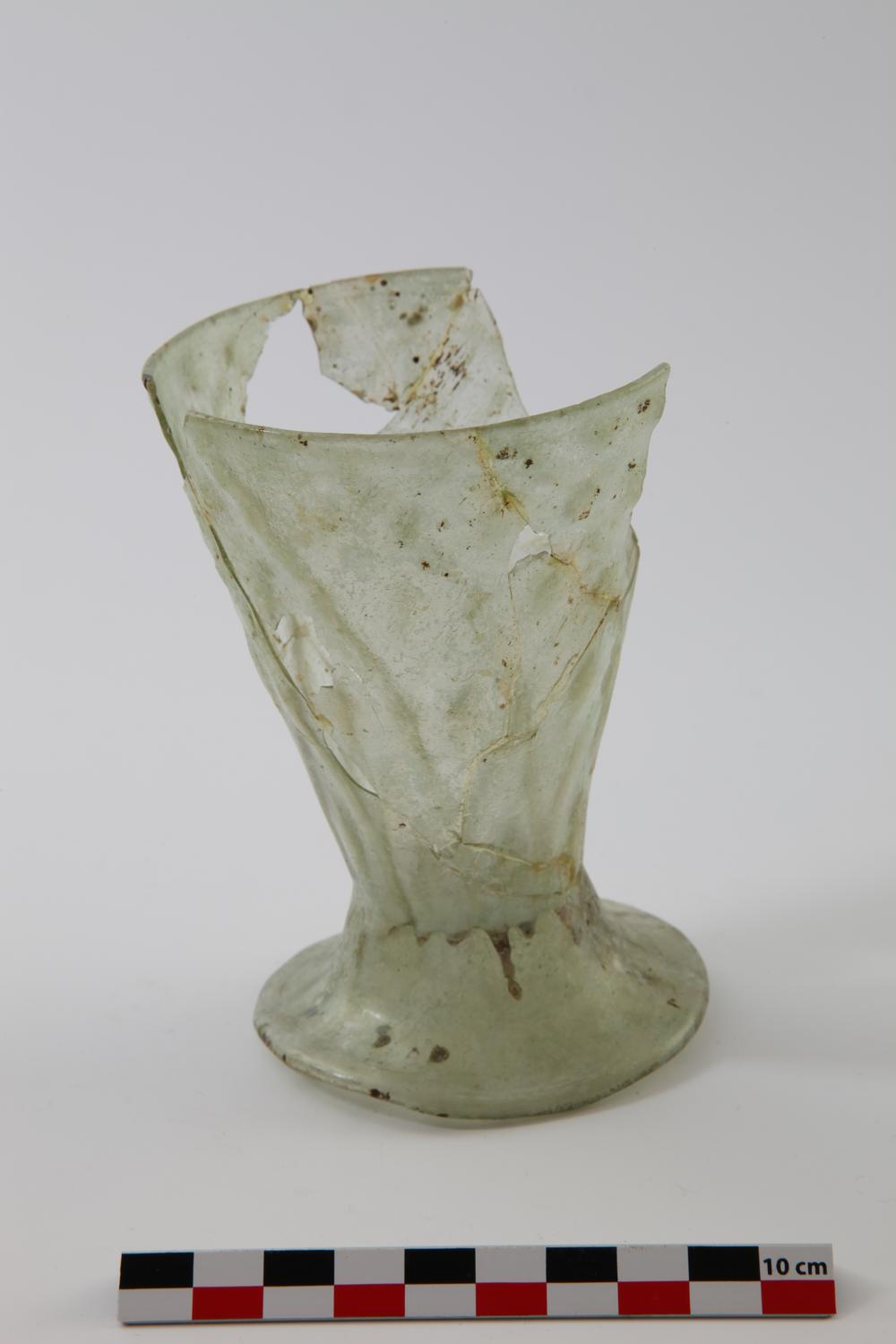
(59/ )
Modern period [1492 / 1789]
Moulded blown glass with pointed rhombuses. Foot pushed back.
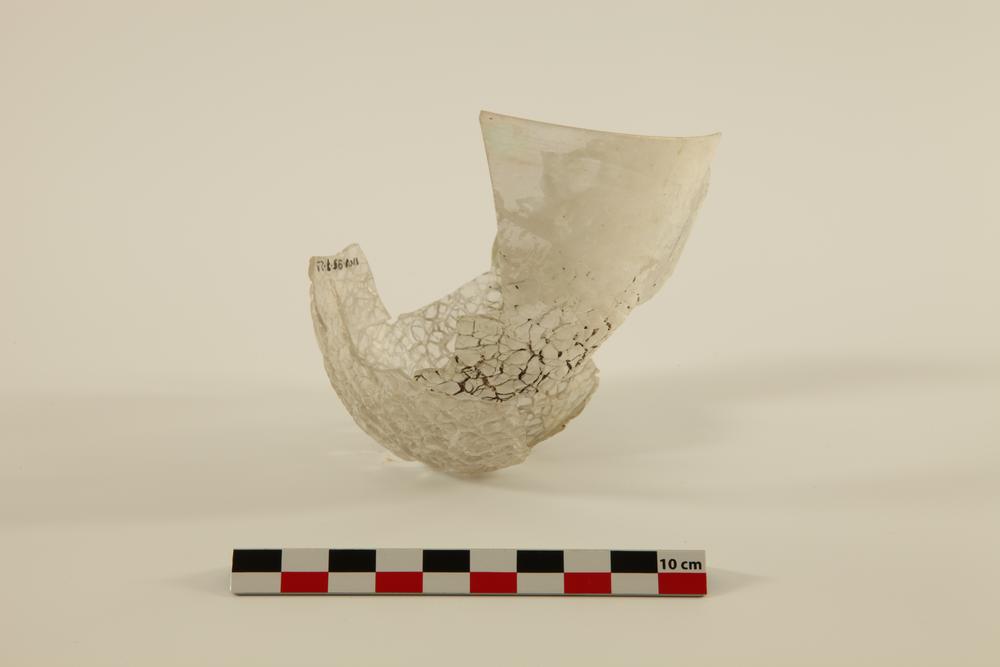
(60/ )
Modern period [1492 / 1789]
Section of a stemmed glass with molded decoration downwards (small imbricated rhombuses). By transparency, we see a network of cracks.
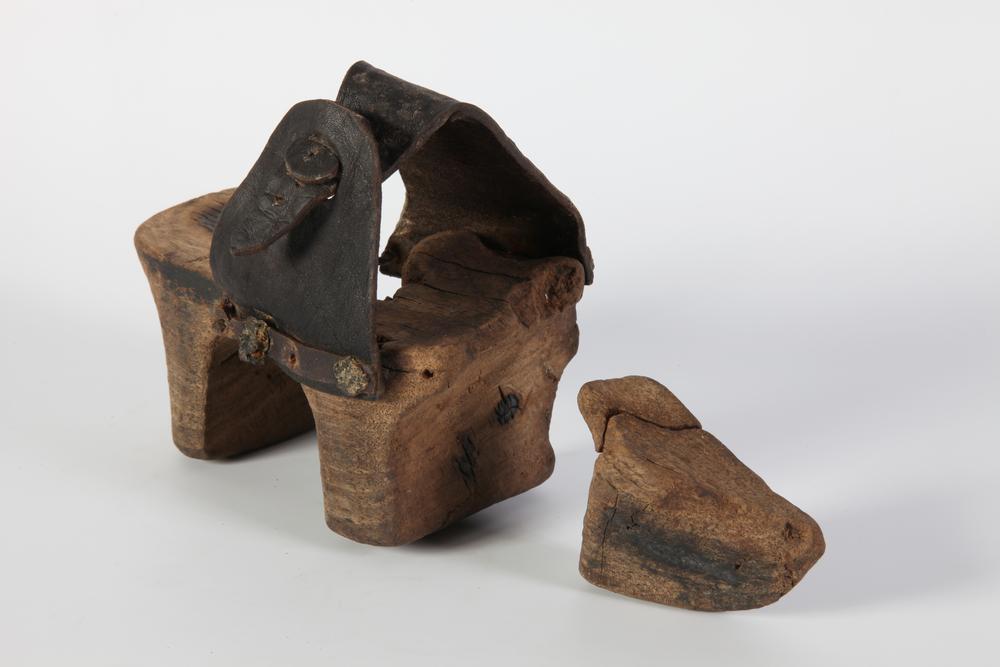
(61/ )
Modern period [1492 / 1789]
Shoe with wooden sole and leather strap covering the front of the foot. It is a kind of clog that allows to walk through muddy streets without dirtying the shoes.
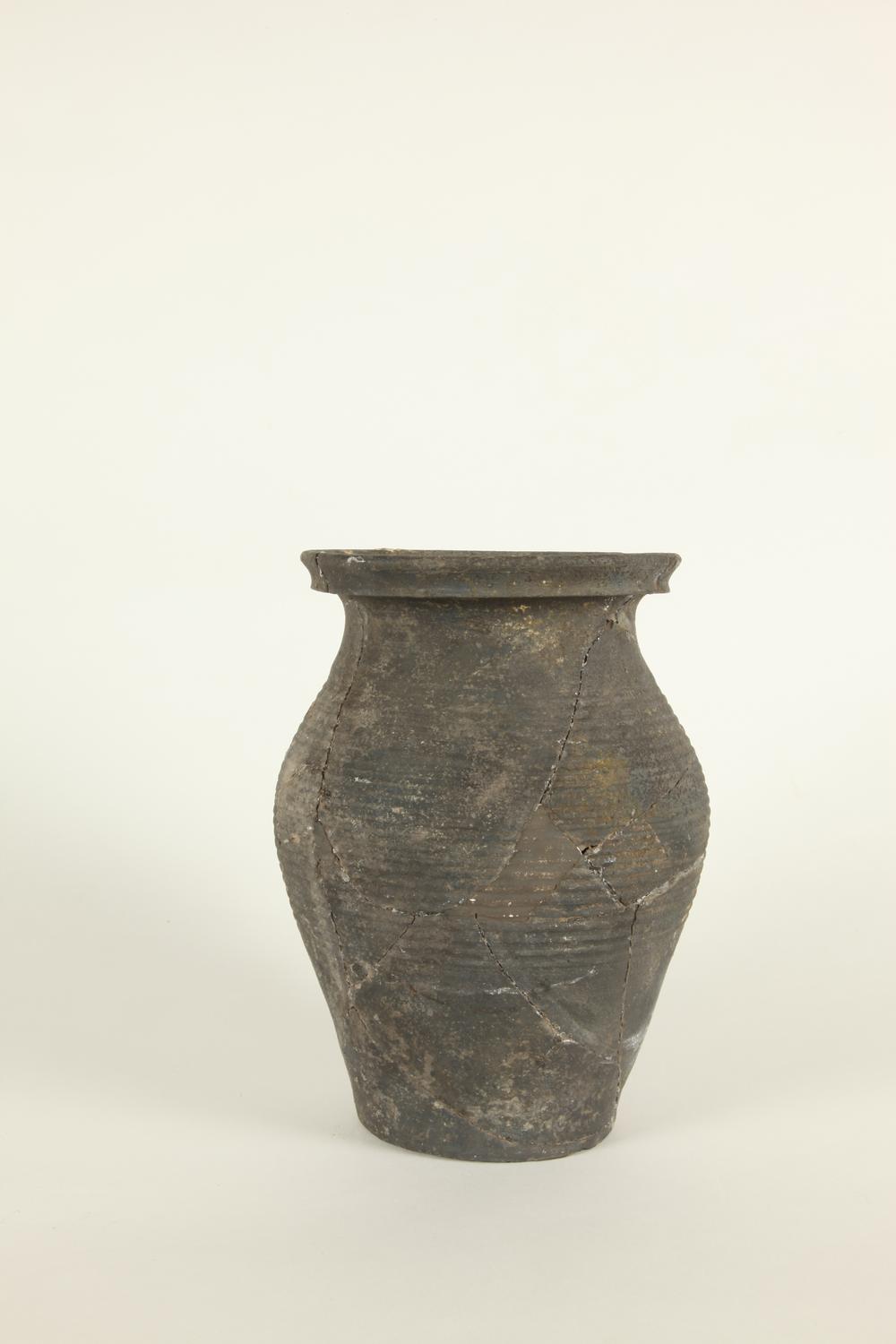
(62/ )
Late Middle Ages [1300 / 1492]
Globular pot with a flat bottom with a decoration of stripes on the body. The inner wall shows traces of turning. The paste has small diameter lime inclusions (max. 1 mm) and has undergone reductive firing. Painted plaster was used to complete the object.
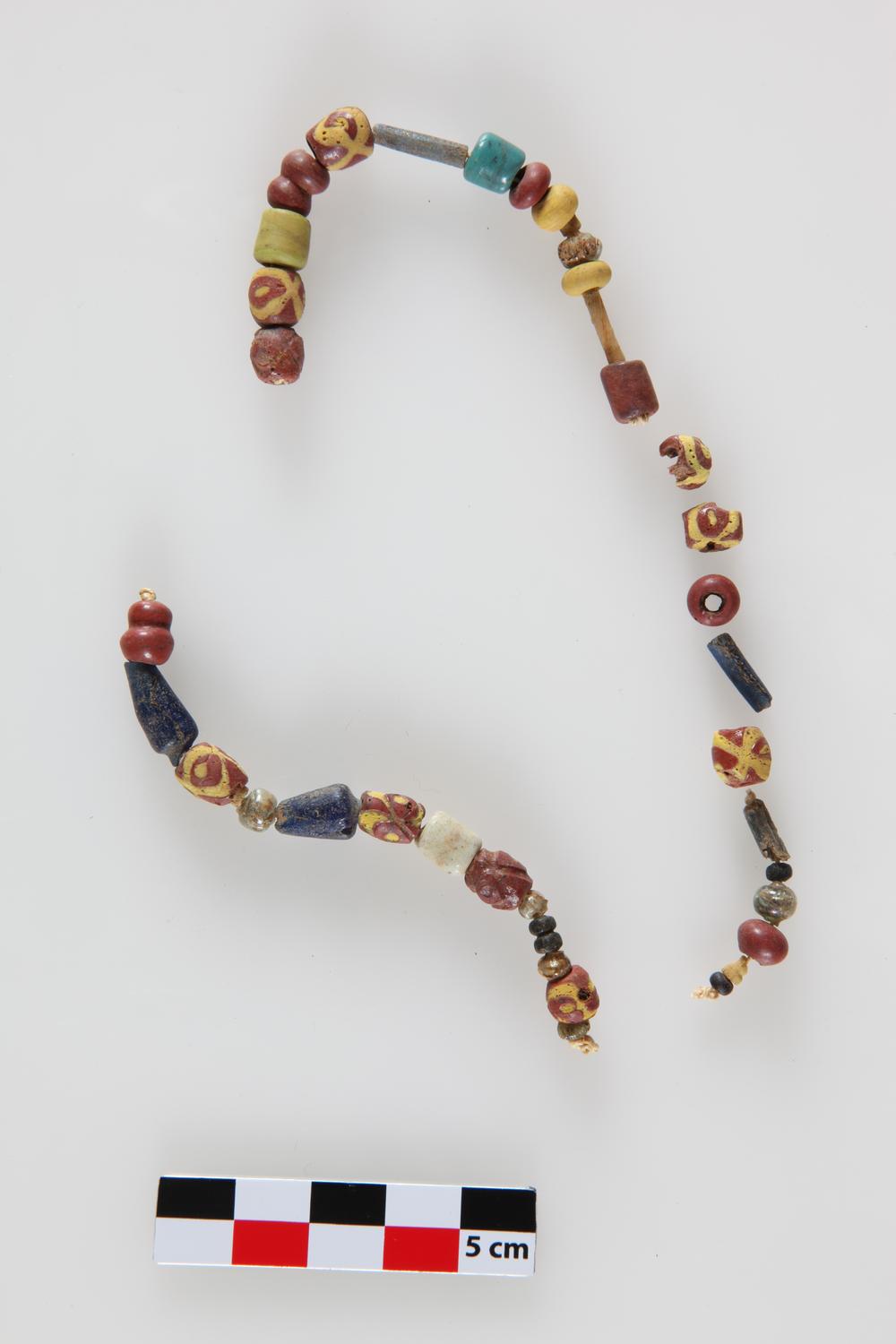
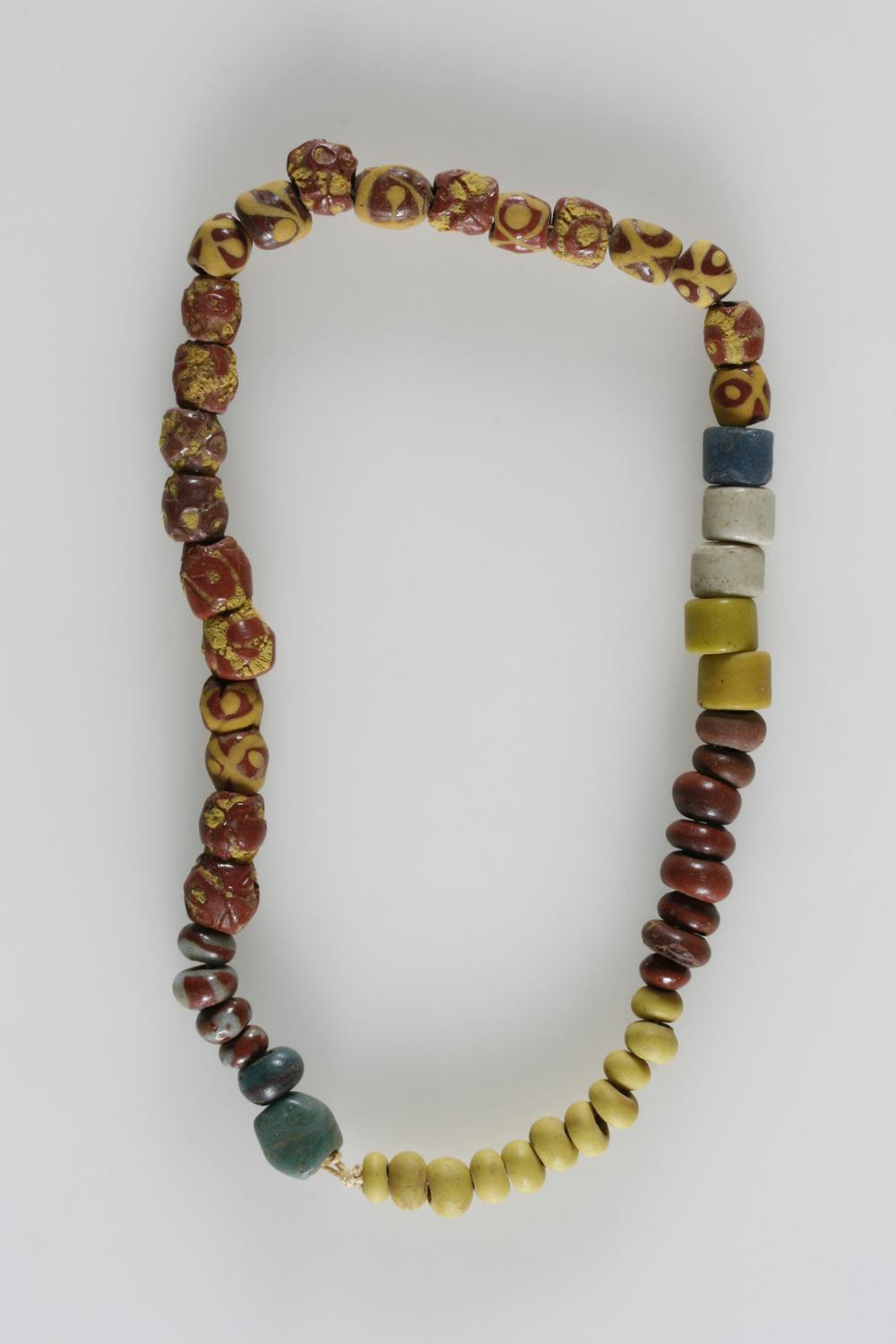
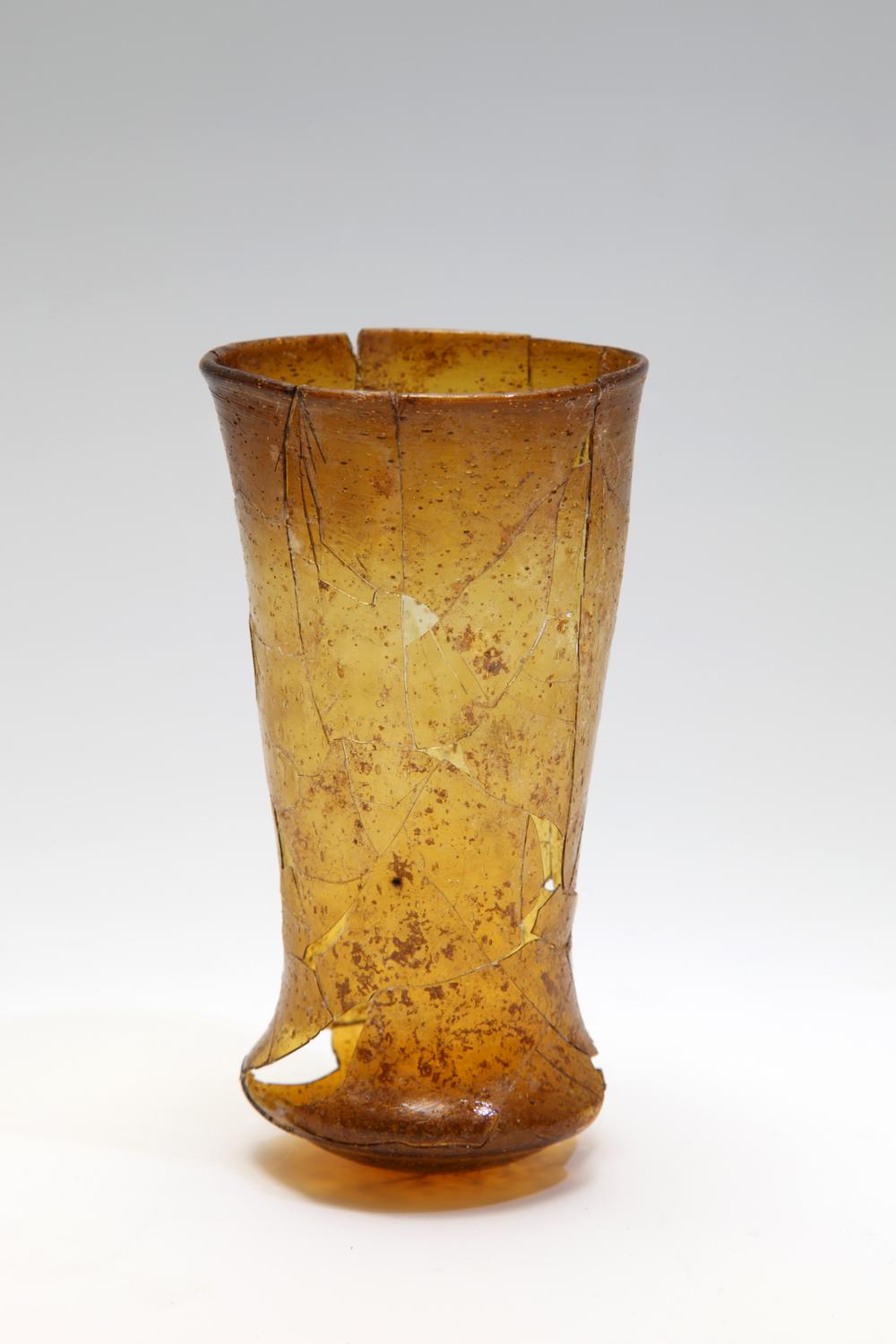

(66/ )
Modern period [1492 / 1789]
Blown cup molded on a serpentine leg formed of a twisted glass tube and glass fins. "The delicate use of glass as illustrated by these two legs once again evokes a Venetian style of manufacture. Although the excavations in Messina have only revealed two examples, the numerous discoveries in other European cities seem to indicate that the use of these drinking glasses was not only reserved for the table of wealthy families."
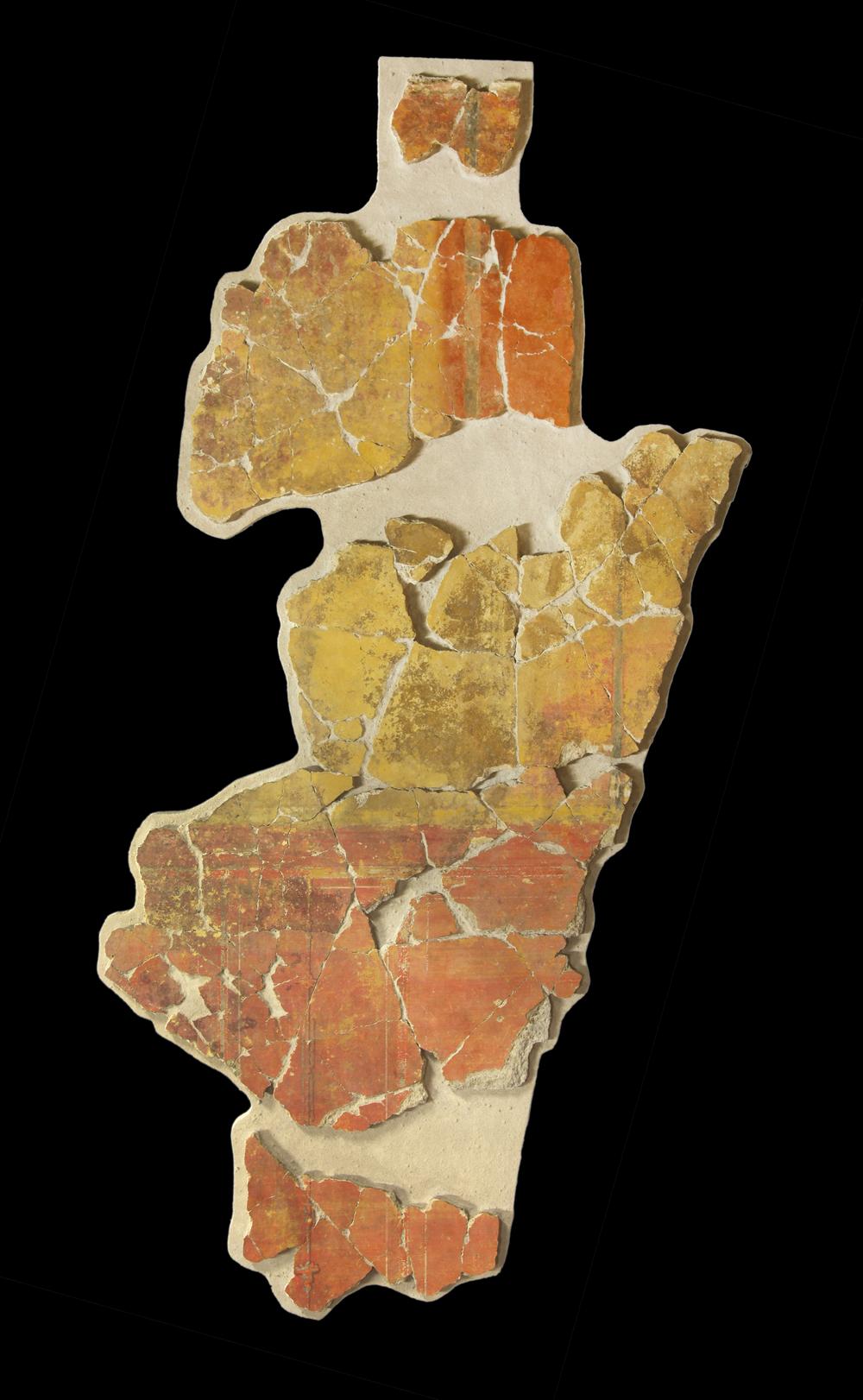
(67/ )
Gallo-Roman [- 50 / 476]
Fragments of ochre, red and golden painted plaster with horizontal bands and vertical borders.
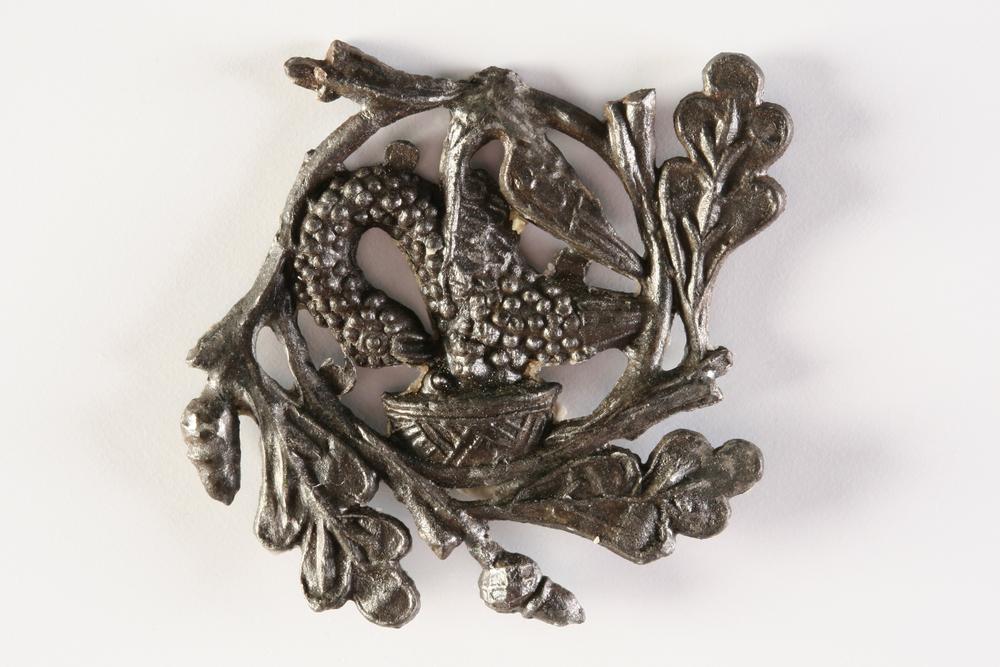
(68/ )
Late Middle Ages [1300 / 1492]
Pilgrimage sign with a pelican; unidentified shrine.